In our series on the great European cathedrals, we asked our fellow travelers to tell us about their favorite cathedrals in Europe, including Spain, Italy, Iceland, Finland, Montenegro, England, Ireland, the Czech Republic, and more.
From ancient times to more modern times, these most beautiful European cathedrals are a worthy addition to any travel itinerary.
The Great European Cathedrals
Table of Contents
ToggleCathedral of Santiago de Compostela, Spain
This cathedral is named after Saint James, one of the apostles whose bones are reputed to be buried in the lower crypt.
It is located in the northwest corner of northern Spain and is the final destination on the Way of Saint James pilgrimage, also known as the Camino de Santiago.
Pilgrims have been flocking to this cathedral since the 9th Century and upon arrival, they are granted a certificate attesting to the completion of their journey.
The legend is that the cathedral is only one of three built over the body of an apostle.
Construction began in the early 9th Century by King Alfonso II of Asturias and Galicia. The cathedral suffered major damage during the reign of the Caliphate when it was burned down.
After the reconquest, it was rebuilt with additions until it reached its current glorious state.
The architectural style is a well-structured combination of Baroque, Romanesque and Gothic. The façade is mainly baroque with heavily ornamented curlicues so typical of the style.
The elaborate interior is stunning with its Romanesque vaulted ceilings, naves and massive organ.
This is the largest Romanesque cathedral in Spain and one of the most beautiful of the European cathedrals.
A stop in this magnificent town should be included in any northern Spain road trip.
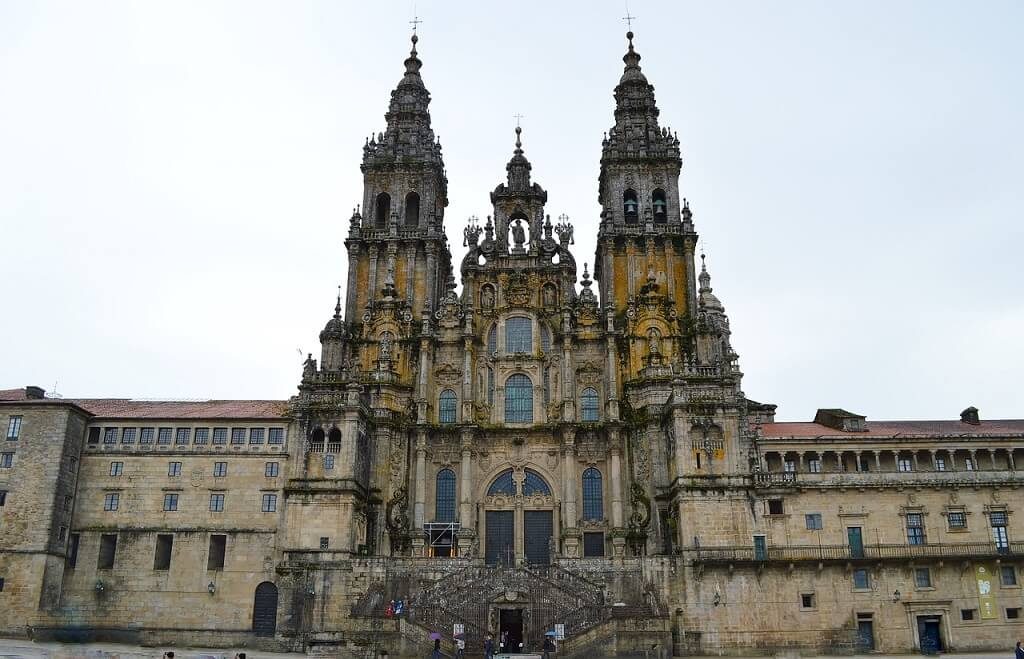
Talek blogs at Travels with Talek
Most buildings, whether they're Gothic cathedrals or Romanesque ones, were high tech for their time. Richard Rogers Share on XBasilica of Montserrat, Spain
Montserrat Basilica is a major pilgrimage spot in Spain, located 50 km (31 miles) northwest of Barcelona.
Its remote location in the Sierra de Montserrat mountain ridge of Catalonia gives it an otherworldly air, and even today, though it draws major crowds during the day, it retains an air of sacred serenity.
While Montserrat, the ‘Serrated Mountain’, has been considered a sacred site since before Christianity, the first monastery was built here around 880 by hermit monks.
The present Benedictine monastery, the Santa Maria de Montserrat, was founded in 1409. The basilica itself dates back to the 16th century and has been the center of turmoil more than once.
After the Peninsular War in 1811, it had to be rebuilt. The facade was again destroyed in the Spanish Civil War and was rebuilt between 1942 and 1968.
Even so, its architecture is not created to outshine its mountain location and blends into its rocky setting.
Inside the basilica is the revered statue of the Black Madonna, the patron saint of Catalonia. This relic is just one of the features that make this one of the great European cathedrals.
This wooden statue, which likely dates back to the 12th century, is believed by some to have been carved by St. Luke and has had a number of miracles attributed to it.
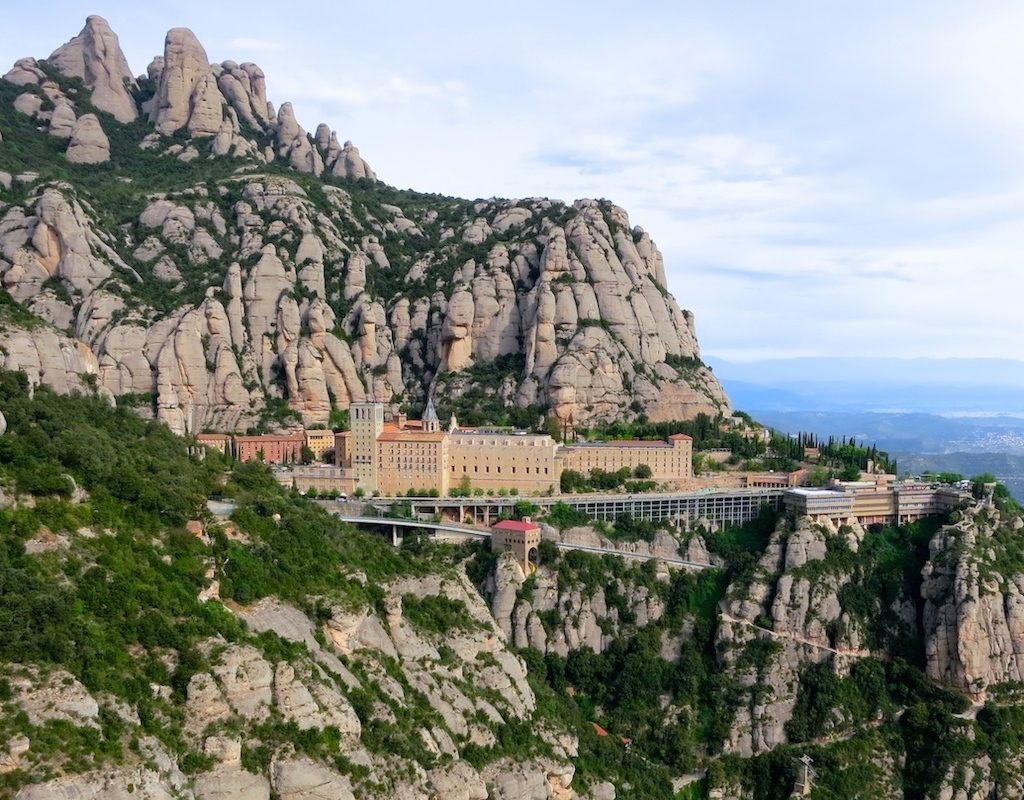
Cathedral of Notre-Dame of Reims – France
The Cathedral of Notre-Dame of Reims is one of France’s most important European cathedrals. It was the site of the coronation of the French kings. Nearly all the kings of France, over 30, were coronated in this cathedral.
One of the most emblematic events was the coronation of Charles VII in 1429, during the Hundred Years’ War.
The coronation of Charles VII was only possible due to the help of Joan of Arc, who influenced the people of Reims to accept Charles VII and switch allegiance.
This was the turning point of the Hundred Years War with England.
The cathedral is also a UNESCO World Heritage site alongside the Palace of Tau and the Abbey of Saint Remi in Reims.
Besides the historic importance of the cathedral, it is a breathtaking site. It is filled with stained glass windows, with a big rose window over the main portal.
When the sun reflects on the windows, the cathedral glows with different colors. One of the most stunning stained glass windows was designed by Marc Chagall. This is truly one of the most beautiful cathedrals in France.
The cathedral also has a big organ and several statues, including one of Joan of Arc.
In the past, there used to be a church labyrinth made on the Nave of the Cathedral, but it was destroyed.
Nowadays, it is only possible to see the projection of the labyrinth in certain events.
From the outside, the cathedral is huge and full of sculpted figures that will capture your eye.
In front of the cathedral, there is a statue of Joan of Arc on a horse.
It is very easy to go to Reims, as it is only 129 km from Paris it is accessible by car or train.
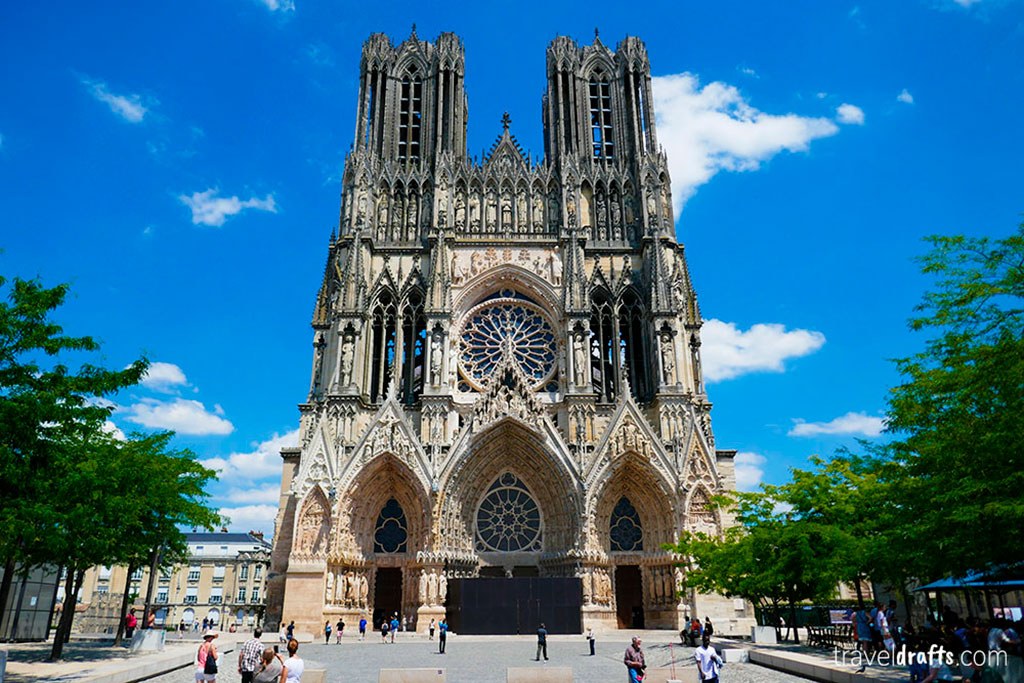
Chartres Cathedral – France
Located in the small city of Chartres is the very large Chartres Cathedral—formally known as Cathédrale Notre-Dame de Chartres.
The Cathedral itself, whose construction began in the year 1205, is a designated UNESCO World Heritage Site and one of the most well-preserved Gothic European cathedrals in all of Europe.
It is the centerpiece of Chartres, France, which is located just 60 miles southwest of Paris.
Chartres Cathedral is home to some of the most important religious relics out there, including the Sancta Camisa—a piece of cloth believed to be part of the tunic worn by the Virgin Mary on the night Jesus Christ was born.
The Sancta Camisa is on display and helps Chartres Cathedral mark the end of a popular pilgrimage destination for this very reason.
A few years ago, Chartres Cathedral underwent an ambitious renovation that cleaned away 800 years of dirt from the interior of the church.
This renovation was not without controversy, but the church now gleams as it did once upon a time.
Regardless of the cleaning, most of the stained glass windows are original—windows that feature a special blue color known as bleu de Chartres.
To this day, no one has been able to replicate this particular shade of blue.
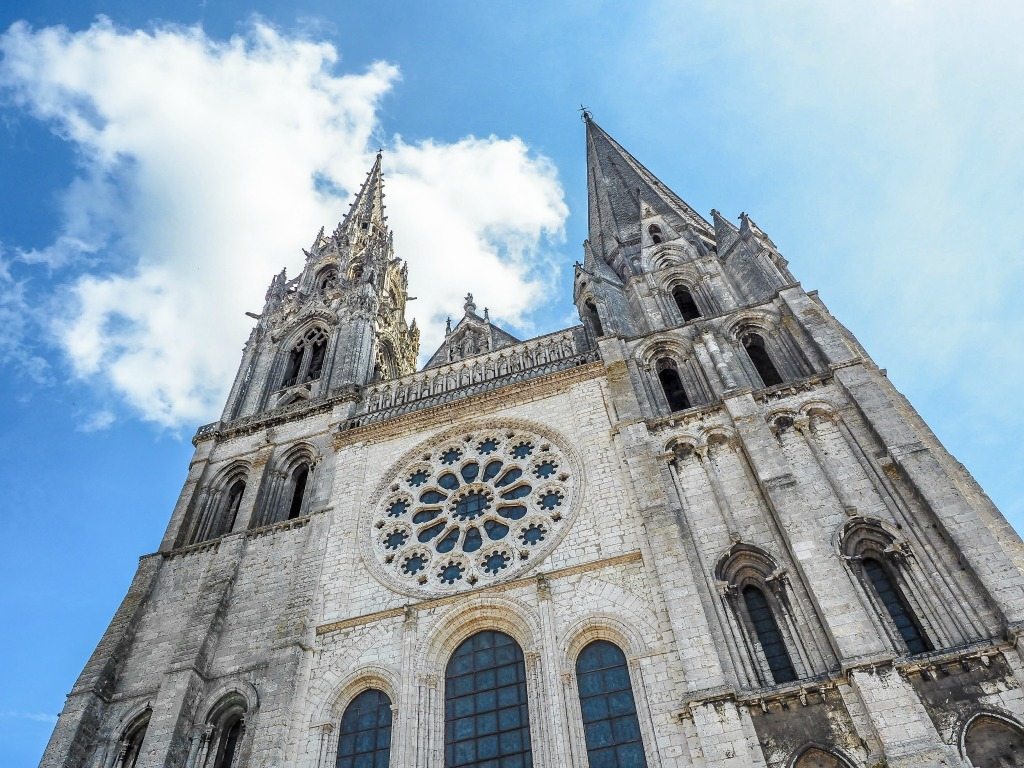
Valencia Cathedral – Spain
This beautiful church is located in the Old City neighborhood of Valencia, Spain. Also called Saint Mary’s Cathedral, this Roman Catholic European cathedral has a long and rich history.
Today, it is one of the most recognizable architectural symbols of Valencia.
The land that this Cathedral was built on was originally the site of a Roman Temple.
Later, it was turned into a mosque. Construction on the cathedral started in the 13th century. However, additions continued to be made to the structure until the 15th Century.
The style is primarily Gothic, but overall mixed. Since construction took place over such a long time, features from different movements were incorporated into its design.
Ultimately, you can find examples of Romanesque, Baroque, Renaissance and Neoclassical styles within its structure. It’s most well-known Baroque feature is the La Porta de Ferros –Door of Iron.
A unique relic of this church is a holy chalice. This chalice is considered by some historians to be the true Holy Grail, which makes this structure one of the great European cathedrals.
This chalice has been dated back to the 1st Century! It is available for viewing at the Capilla del Santo Caliz of the cathedral.
Tourists can visit the Cathedral and its museum Mondays through Saturdays. The entrance fee is 8 euros, and an additional 2 euros to climb the el Miguelete.
Once at the top of the El Miguelete or Miguelete Tower, you’ll be rewarded with fantastic views of Valencia.
Entry to the museum also includes an audio guide. The museum features many beautiful frescoes.
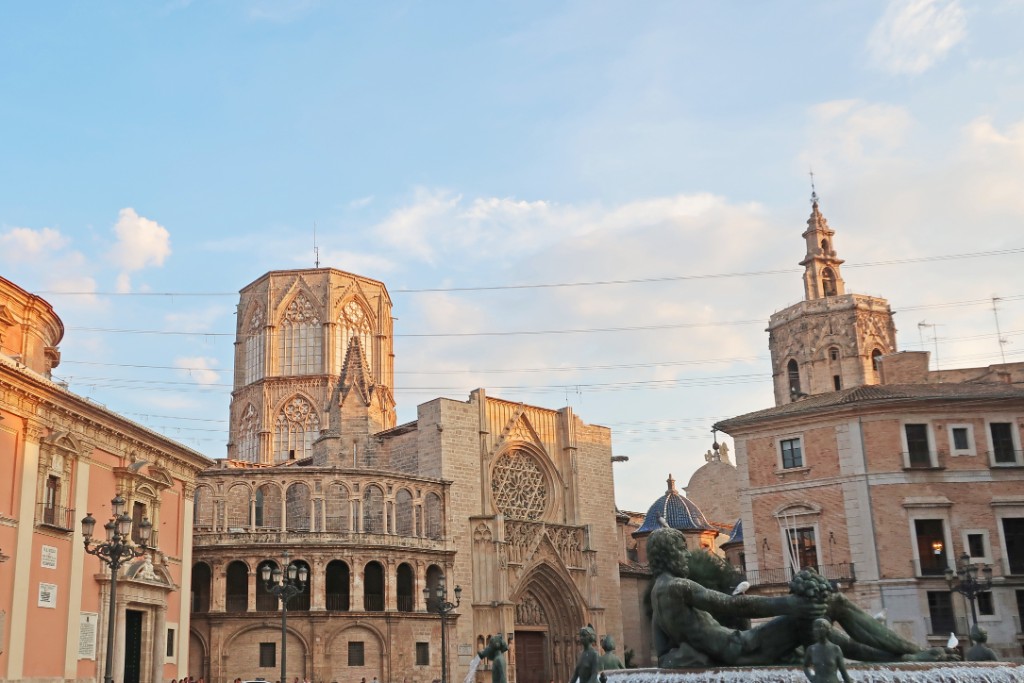
Aachen Cathedral – Germany
It may not be the biggest – or even the most famous these days – but, in many ways, Aachen Cathedral is the most important cathedral in Germany.
It was at the core of the country’s politics and faith for centuries, with 42 German kings and queens crowned here between 936 and 1531.
But there was one ruler who will always be the most associated with Aachen Cathedral – the legendary Emperor Charlemagne, who united much of Western Europe and created the foundations of Germany and France.
He was the one who built this cathedral and his remains are still housed within it in a large shrine.
Construction of Aachen Cathedral began in 796 and it actually takes its inspiration from churches that were found in the eastern part of the Holy Roman Empire in those days – places like Serbia or Greece.
The core of the cathedral has an octagonal shape that goes up for several levels.
The core is decorated with textured marble and elegant columns. In the smaller chapels, every inch of the walls is covered in art.
When you go further in, the vaulted ceiling seems so much higher than you might expect from the outside, and the enormous stained-glass windows beam in bright colours.
The size of Aachen Cathedral, smaller than the other main German cathedrals, makes it seem even more impressive in some ways.
There’s a concentration and intensity to the colours, the grandeur and the art. You can feel the history here.
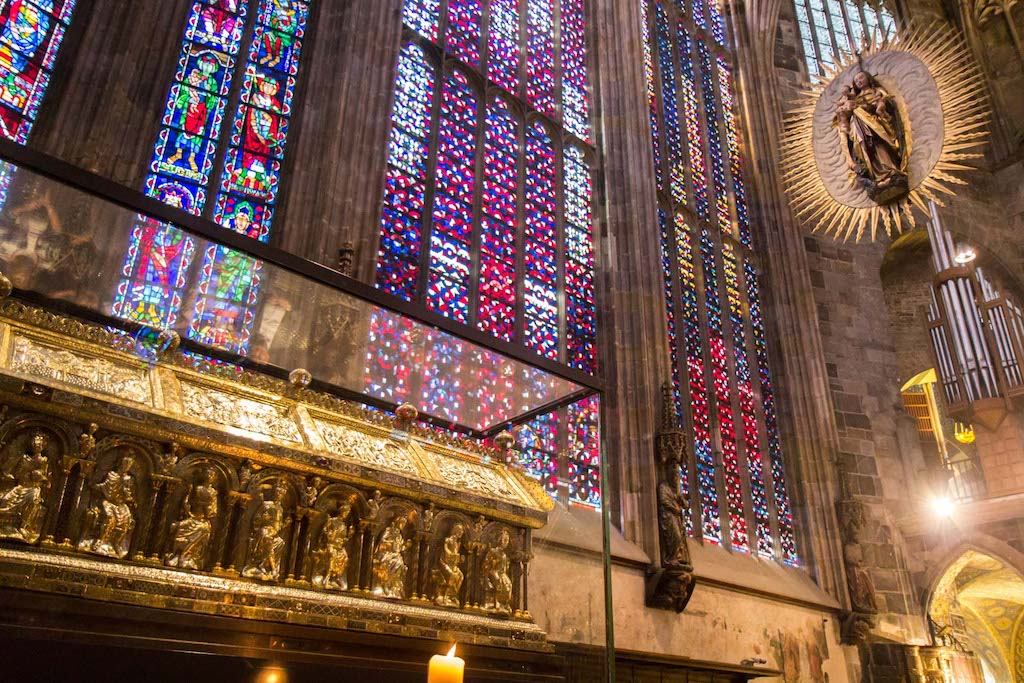
Cathedrale Notre-Dame de Strasbourg – France
Located in the center of the city of Strasbourg, the Cathedrale Notre-Dame de Strasbourg is a massive, Gothic style European cathedral winding its way high above the town’s rooftops.
It is currently the 6th tallest church in the world and allows for visitors to climb up to the top platform and get a spectacular view of the city.
Its history is an interesting one, as much of its construction was due to private donations received by local citizens.
A variety of architects were also involved in the design and construction of various parts of the cathedral with no one person taking credit for the entirety of the cathedral.
The cathedral was the tallest building in the world for over 400 years!
The interior of the cathedral is exquisite and contains various mural paintings and stained-glass windows dating as far back as the 12th century.
Instruments, including the large organ as well as Gothic sculpture statues, are also relics that give the cathedral a vintage look.
An astronomical clock, which unfortunately is no longer working, was put together by a variety of artists, representing life stages as well as the last Judgment.
The façade of the cathedral is spectacular, and when walking along the streets of Strasbourg and turning towards the entrance of the cathedral, its enormity is quite stunning.
It has an overbearing presence in an otherwise mid-size city and has also inspired men such as Victor Hugo and Goethe.
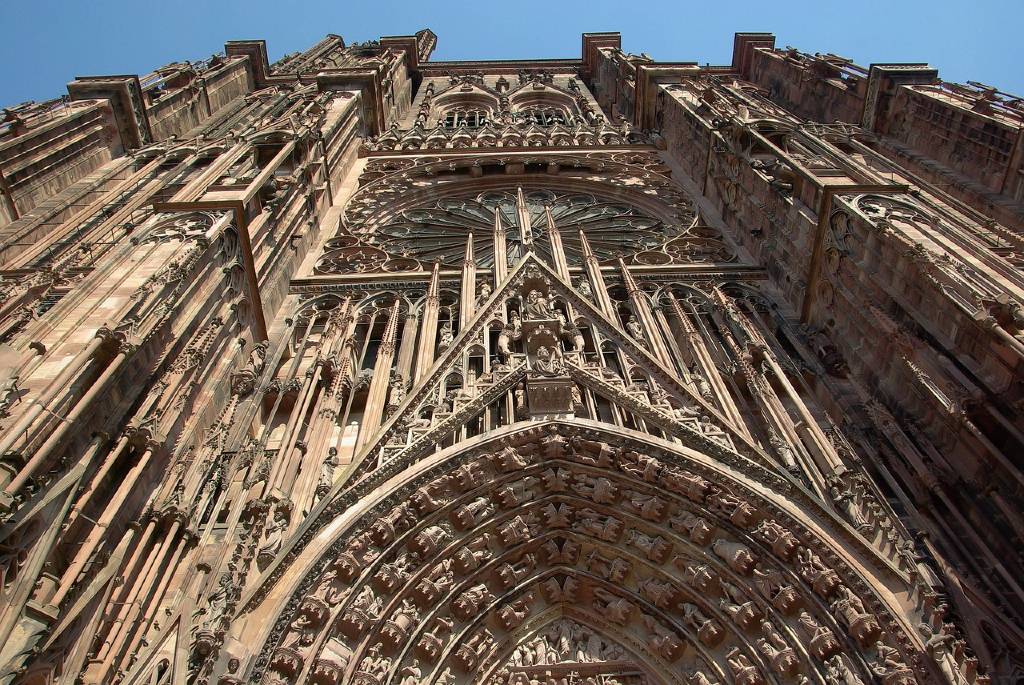
St. Tryphon’s Cathedral – Kotor, Montenegro
Kotor is one of the most stunning towns in Europe. Its Old Town is incredibly well-preserved, and it takes you back in time with its stunning architecture and old-world charm.
There are countless pictures of Montenegro to prove it, and after you’ve seen them, we’re sure you’ll add this Balkan country to your bucket list. It’s a magical place nestled by the Adriatic Sea.
Right at the center of Kotor, which is fittingly a UNESCO World Heritage Site, you can find St. Tryphon’s Cathedral, a majestic monument that dates back to the 12th century.
It was built in the name of St. Tryphon, the patron and protector of the city of Kotor. This cathedral, one of two in the whole country, is stunning both from the outside and the inside.
You’ll find frescoes from the 14th century, intricate ornaments, and vast decorations in the romanesque style. On the upper part of the cathedral, there’s actually a Sacral Art Museum.
St. Tryphon’s Cathedral has changed through time and has been rebuilt more than once due to earthquakes: first after the 1667 Dubrovnik earthquake and more recently after the 1979 Montenegro earthquake, which vastly affected the country’s beautiful coast.
Today the cathedral is fully restored and serves as the seat of the Catholic Bishopric of Kotor.
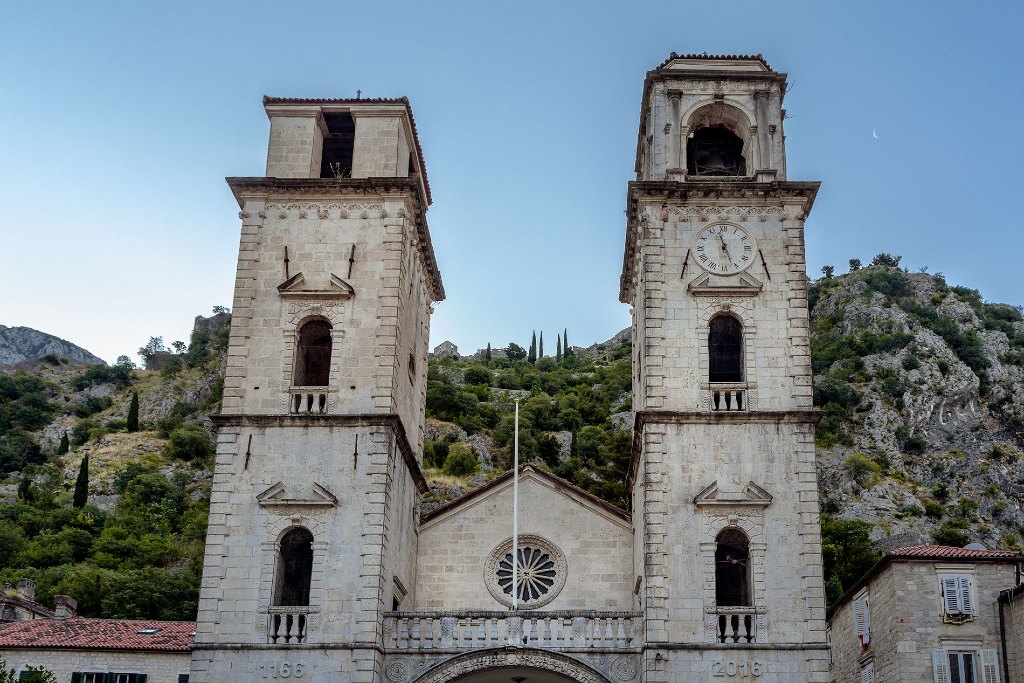
Catedral de Santa Maria – Girona, Spain
The Catedral de Santa Maria is one of the most beautiful sights in the city of Girona, the capital of Costa Brava, in Catalonia.
The church was built between the 11th and the 18th centuries following a variety of styles. Among the many styles used are the Romanesque, the Gothic and the Baroque.
There are 90 steps leading to the cathedral, which can be viewed from a distance. Inside the church, you’ll be able to admire the beautiful stained glass and to visit the Cathedral Treasury Museum.
This holds the Tapís de la Creació (Tapestry of Creation), an embroidered panel in Romanesque style that dates back to the 11th century and which is remarkably well preserved.
The best views of the cathedral are from the defensive walls that run through the old town of Girona.
They can be accessed from three points. One of them is the gardens behind the cathedral, one by the Monestir de Sant Pere de Galligants and the last one by the Spanish Civil War Memorial.
I recommend starting at the Spanish Civil War Memorial and walk all the way to the Cathedral from there. The views as you approach it are breathtaking.
On a final note, you may be glad to note that the Cathedral of Girona is one of the filming locations of the popular series Game of Thrones.
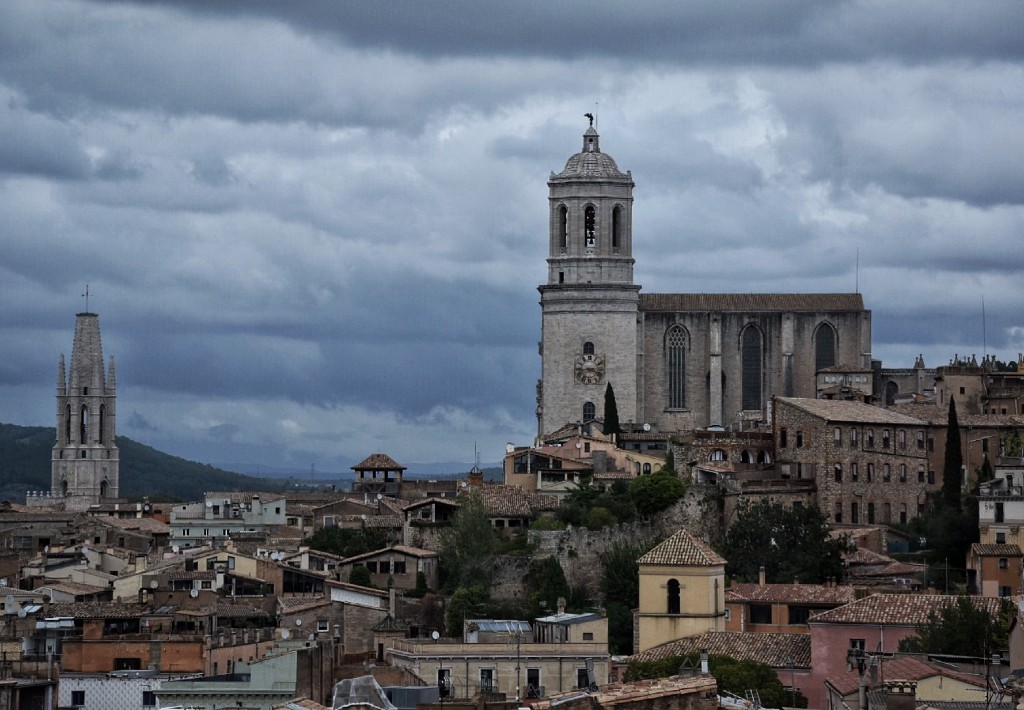
St. James Cathedral – Innsbruck, Austria
Innsbruck is a picturesque city in the heart of the Alps in Austria. The town is compact and easy to walk around, with lots of stunning architecture to admire, particularly in the old part.
The Cathedral of St. James is one of the city’s most famous buildings. It’s located by Hofburg Palace in the old part of the town.
It’s believed that there has been a church here since 1180. The cathedral that stands here today was built in the early part of the 18th Century after an earthquake destroyed the previous church.
It was designed by Johann Georg Fischer and Johan Jakob Herkomer, and the Baroque architecture with its two green domes makes it an easy-to-recognise landmark in this part of town.
The structure was heavily damaged during World War II, but thankfully, it is now fully restored and well worth a visit.
The interior of the cathedral is exquisite and richly decorated with pink marble and gold leaf.
The organ is particularly impressive with its golden facade and elaborate decorative statues.
It has 3,729 pipes and 57 registers and its presence dominates the gallery in the west wing.
Another highlight of the cathedral is the tomb of Archduke Maximilian III, Grand Master of the Teutonic Knights.
It lies beneath a canopy that is supported by four bronze pillars. Each of these pillars is elaborately decorated with vine leaves, birds, and small animals.
On top sit several beautiful bronze figures, including one of the Archduke himself dressed in Armour.
The cathedral has eight bells, one of which, the Mariahilferglocke, is the second largest in the Tyrol.
These bells can be heard only on a Friday. The chimes that ring out each day just after noon are from the cathedral’s peace carillion (musical instrument).
The cathedral has the largest carillon in Austria, consisting of 48 bells that are housed in one of the towers.
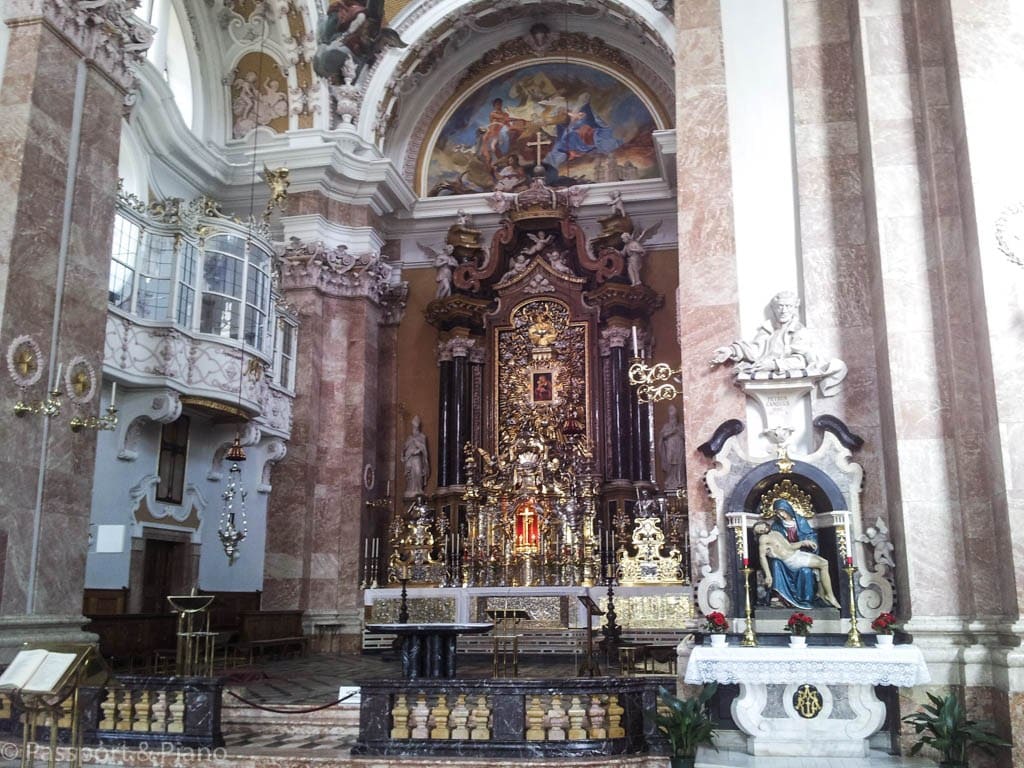
Basel Münster – Switzerland
Basel, Switzerland, sits on the corner where France, Germany, and Switzerland meet. One of the most important sights in Basel is the Münster (or Cathedral in English).
The Basel Münster sits high above the Rhine River on a location where the Romans once had a fortress. It is located in Basel’s Old Town and is easily reached by public transport or on foot.
For a more unique arrival, you can always take a traditional fähri across the Rhine!
The cathedral was built and rebuilt several times between 1019 and 1500. Once a Catholic Cathedral, it became Protestant after the Reformation in the early 1500s.
From its red sandstone architecture and coloured roof tiles on its exterior to the pipe organ and stained glass inside, the Basel Münster is a truly beautiful cathedral.
While visiting, make sure to visit the cloister and crypt where the tombs of royalty and prominent citizens of Basel were buried hundreds of years ago.
The Basel Münster has two façade towers, one of which can be visited. It originally had five but all fell during an earthquake in the 1300s and only the existing two were rebuilt.
If you wish to climb the tower, beware, it isn’t an easy task. The 250 stairs are narrow and winding and the upper areas are quite open.
That said, the hard climb is well worth it. The top of the tower has a spectacular view of the Rhine and Mittlere Brücke, Basel’s famous Middle Bridge.
The square in which the Münster stands is often a place of concerts and other events. There is also a beautiful terrace behind the church, which has one of the best views in Basel, making this one of the prettiest European cathedrals.
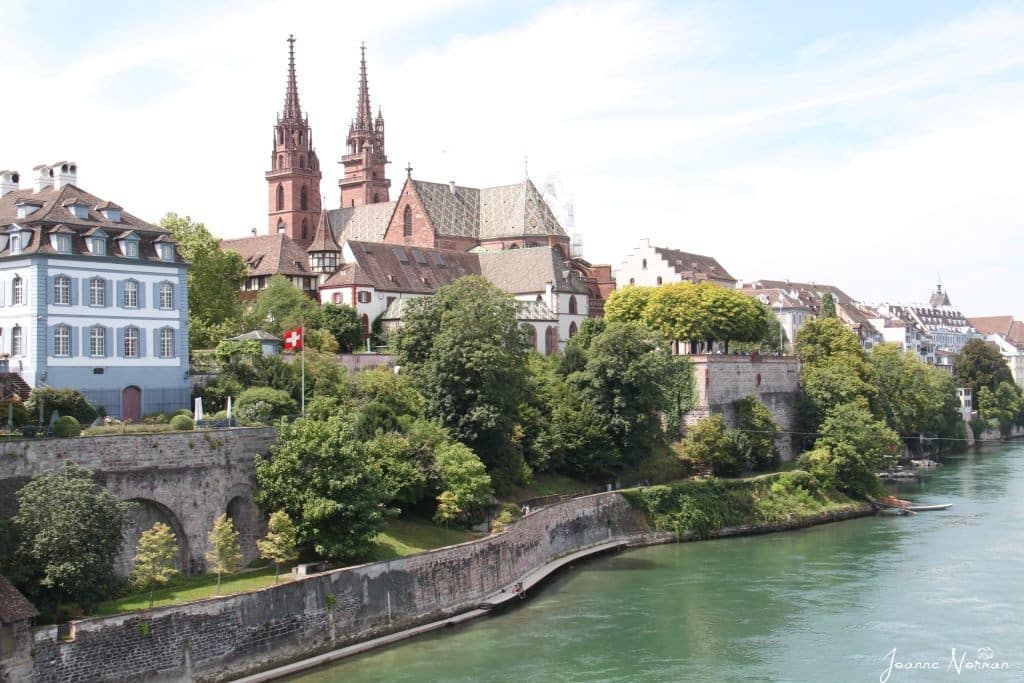
Sainte Reparate – Nice, France
Nice, France actually has two impressive European cathedrals: One is Saint-Nicholas Russian Orthodox Cathedral used for worship by the large Russian community that settled in Nice in the 1800s.
The other is the Sainte Reparate Cathedral for the Catholic community.
Reparate is the patron saint of Nice and was a young woman martyred in Palestine during the persecutions of Emperor Decius in the 3rd Century.
Her relics arrived in Nice in 1060 and were placed in a chapel called Sainte Marie’s up on Castle Hill, which used to be the original heart of Nice.
Around 1000 CE, Nice expanded; people moved down from Castle Hill and new settlements were set up at the base.
A new church was built in 1075 to house her relics, and this new Baroque-style church was called Sainte Reparate.
The initial church took over 50 years to build but continued to be enlarged over several hundred years.
It had been remodeled after the church of Santa Susanna in Rome. Sainte Reparate’s church finally received Cathedral status in 1590.
The cathedral was consecrated in 1699, and the clock tower was added onto the right side of the Cathedral in 1757. The façade you see today wasn’t finished until 1830.
There are 10 Baroque chapels inside with ornate altarpieces, and the high altar houses the remains of Reparate and has a painting of her above it.
The cathedral is located in Place Rossetti in the Old Town of Nice. There is a small buzzing piazza with cafes and restaurants, and it’s a common meeting place for locals and tourists alike.
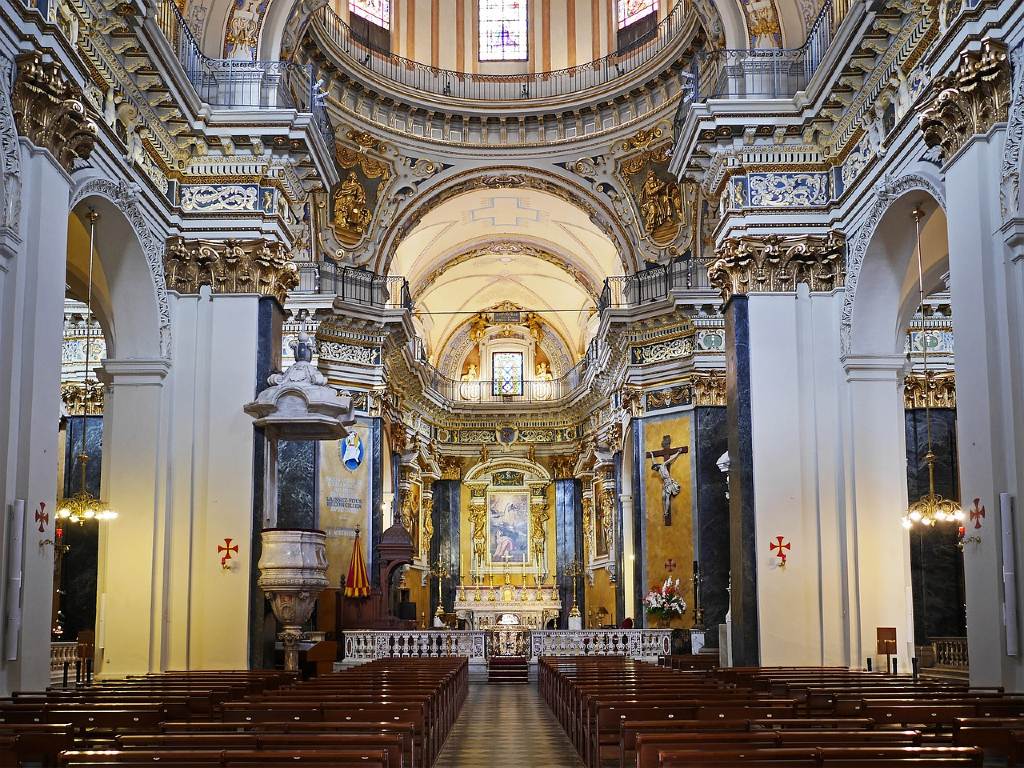
Helsinki Cathedral – Finland
There are two famous cathedrals in the heart of Helsinki, Finland.
The Helsinki Cathedral is located in the heart of the city center and is the Evangelical Lutheran Cathedral of the Evangelical Lutheran Church of Finland.
It is a very popular sightseeing stop for lots of tourists but is also still a place of worship for hundreds of churchgoers today.
It is a beautiful white cathedral with emerald accents and is a stunning building with a lot of details around the church.
This cathedral was built in 1824 and completed in 1852. The Helsinki Cathedral seats 1,300 people in its sanctuary.
It is a church that is used every week for regular services and is still used for special events like weddings, baptisms, and funerals as well. Helsinki Cathedral is perched up high on dozens of steps, so it will be a bit of a climb if you want to go up to see it close.
Inside, the church has statues, an impressive organ, and murals around the building. Tourists can step inside and enjoy both the inside and outside on their visit.
The outside has strong pillars and overlooks the city center. It’s a great place for some photo ops of this amazing cathedral.
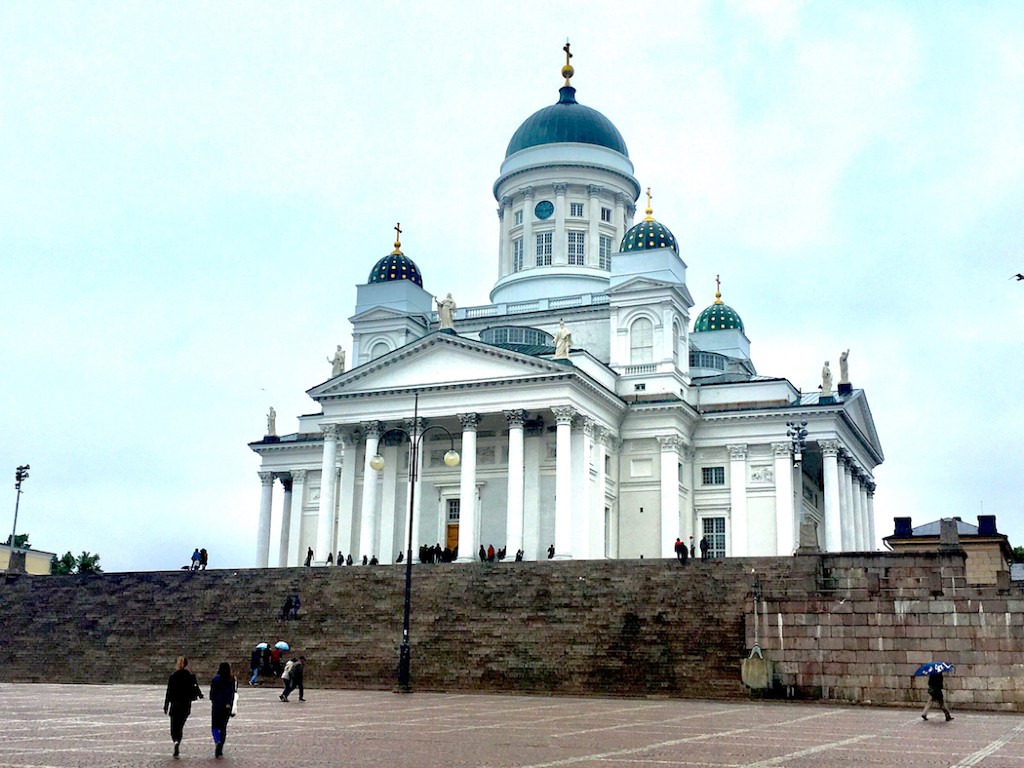
Hallgrímskirkja – Reykjavik, Iceland
Hallgrímskirkja stands proudly in the center of Reykjavik and is probably the only concrete building in the world that I’ve considered beautiful.
We visited Reykjavik at the end of our five-day Iceland itinerary with kids last year, and our first stop in the city was to marvel at this impressive Lutheran church.
At 73 meters tall, it is the largest church in the country and is named after Hallgrímur Pétursson, the author of the Passion Hymns.
Pop inside to thaw out from the bitter cold and check out the gargantuan pipe organ designed and constructed by the German organ builder, Johannes Klais of Bonn.
Then take the lift to the top to breathe in the extremely impressive views. Yes, a lift (elevator) in a cathedral! That’s a novelty!
Unlike most cathedrals throughout Europe, Hallgrímskirkja is very modern; construction started in 1945 and was completed in 1986. So there are no narrow winding staircases to the top here!
Although do arrive early to beat the queues. On a clear day (which is certainly not guaranteed in Iceland), the observation tower offers a perfect 360-degree panoramic view of the city and harbor and beyond. Entry to the tower is ISK 1000.
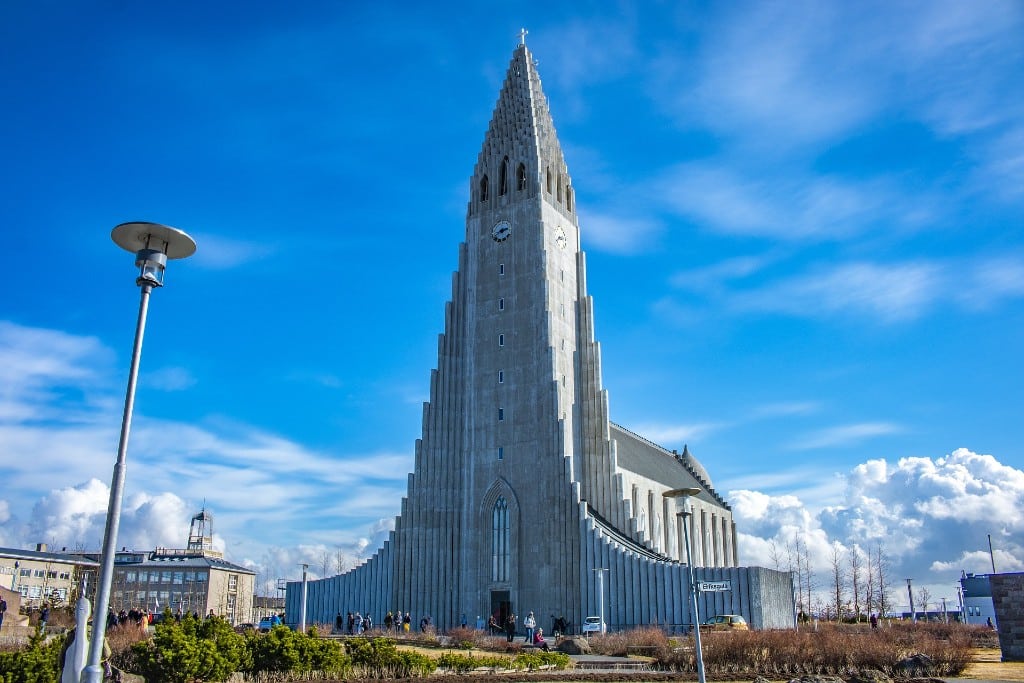
Cathedral of the Incarnation – Granada, Spain
The Cathedral of the Incarnation in Granada in Andalucia is the third largest cathedral in Spain. Its construction started in 1523 and finished in 1704.
The church was built on the site of a Mosque as Granada used to be the capital of the Moorish Kingdom until 1492, when it was conquered by Queen Isabella I of Castille.
The construction was started by Enrique Egas, the master of the Old Gothic School. His work lasted only 5 years and was focused on the foundations.
Then Egas was replaced by Diego of Siloam, who received his education in Italy. He changed the style from Gothic to Renaissance. Inside the Cathedral, we can see many chapels built in different ages and styles.
What’s interesting about the Cathedral is the fact that it has only one bell tower. Originally, there were two towers planned, but only one was built.
Moreover, it was lowered because the Gothic foundations could not resist the heavy mass of the tower. Therefore, it’s said that the cathedral is still incomplete.
Inside the cathedral, there is a small museum in the sacristy.
The exhibition includes a crown and a scepter of Queen Isabella, the sword of King Ferdinand and flags used during the seizing of Granada in the 15th century, as well as paintings of Hans Memling and Sandro Botticelli.
On the left side of the cathedral, you will see the Royal Chapel of Granada. The facade of the chapel is in the style of Isabelline Gothic.
It was the dominant architectural style during the reign of Isabella I of Castile.
The Catholic Monarchs, Isabella I of Castile and her husband Ferdinand II of Aragon, are buried there as well as some other members of the royal family, including Joanna the Mad and Philip the Handsome.
Try to include a visit to this impressive European cathedral on a southern Spain road trip.
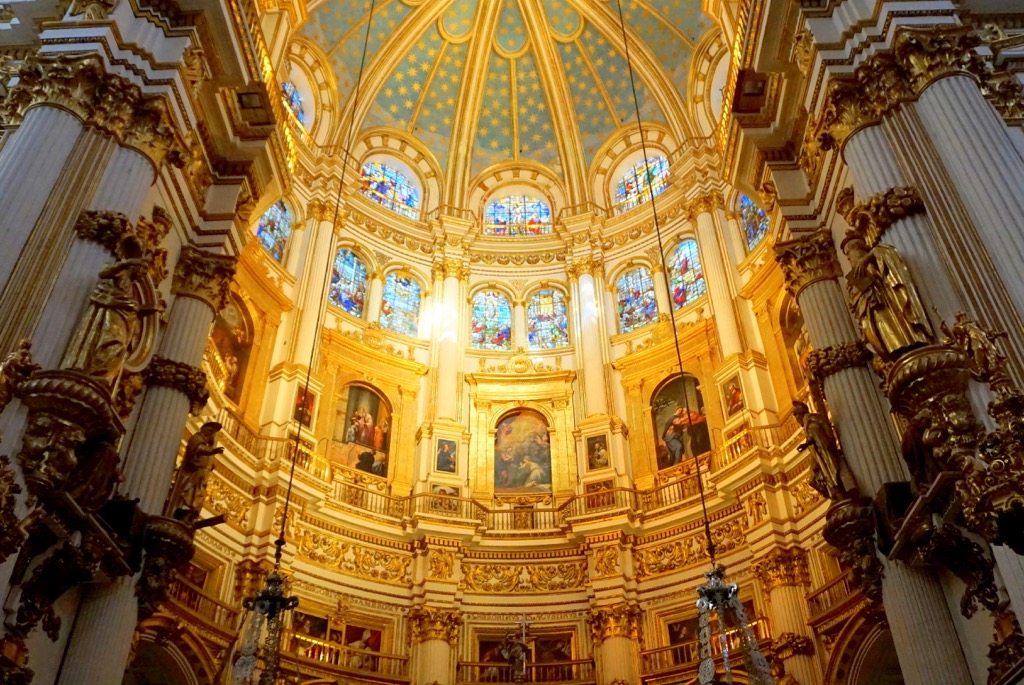
La Sagrada Familia – Spain
Anyone and everyone who’s thought about visiting Barcelona has seen or heard of the beautiful La Sagrada Familia church.
This is one of the most famous cathedrals in the world. It was designed by Antoni Gaudi and is still in the works. It has taken over 130 years to build and is still not complete!
It is estimated to be completed in 2026.
Sagrada Familia is one of the most famous works of Antoni Gaudi and, along with 6 other Gaudi buildings, is also a UNESCO World Heritage site.
The building consists of 3 beautifully unique facades: nativity, passion, and glory. The Nativity facade was the first to be completed and was built between 1894 and 1930.
It was dedicated to the birth of Jesus and is decorated with naturalistic elements.
A characteristic of Gaudi’s style, it was the only facade to be constructed while Gaudi was still alive.
He wanted to work on it because it would make the church’s architecture more attractive and accessible to the public.
The passion facade is more modern, with clean lines resembling bare bones.
This is because it was meant to strike fear into anyone viewing the building and depict the brutality of Christ’s sacrifice.
The glory facade is currently still under construction and is meant to be the main facade offering entrance into the building.
This facade represents the road to God with death, final judgment, and finally glory, with hell awaiting those who disobey God.
Aside from the amazingly designed facades, the church also has a total of 18 spires representing the Twelve Apostles, the Virgin Mary, the Four Evangelists, and Jesus Christ.
After the spires are completed, the Sagrada Familia will be the tallest church in the world.
The cathedral is insanely beautiful, especially when its nave is filled with light shining through its stained glass windows. It is well worth a visit!
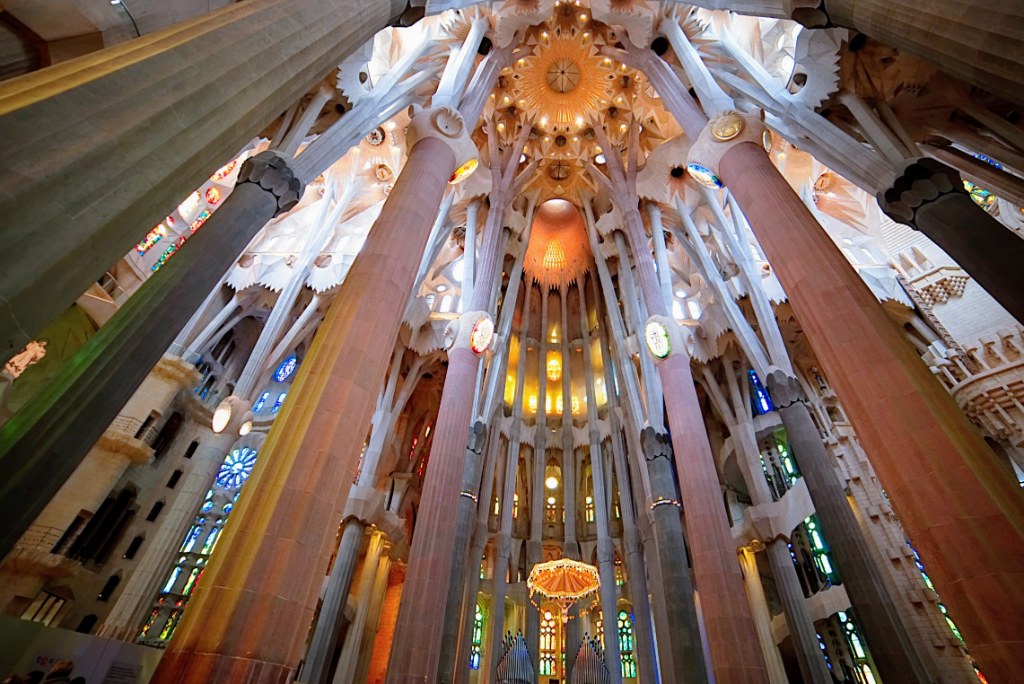
Orvieto Cathedral – Italy
Orvieto Cathedral is situated in an incredible spot: positioned atop a volcanic cliff, it is visible across the Umbrian countryside from quite a distance.
Although initially begun in the Romanesque style, Orvieto Cathedral is predominantly Gothic, constructed during the 13th and 14th centuries, with Lorenzo Maitani responsible for much of its impressive design.
It is said that Maitani was influenced by the cathedrals of Siena and Florence, but whatever his influences, the resulting structure is quite magnificent.
The decorative façade features detailed sculptures, including stories from the Old Testament, and there are beautiful mosaics depicting the story of the Virgin Mary.
In the center of the cathedral’s façade is an intricately designed rose window with Christ’s face at its center.
The interior of Orvieto Cathedral is not as dramatic as its exterior, but it does house significant fresco cycles by Fra Angelico and Luca Signorelli in its Cappella della Madonna di San Brizio.
These were completed in the 15th and early 16th centuries. The frescoes of Signorelli (said to be the best of his career) are not for the faint-hearted: they depict the Apocalypse and the Last Judgement.
The Umbrian town of Orvieto is midway between Rome and Florence and can be reached in an hour by train from Rome.
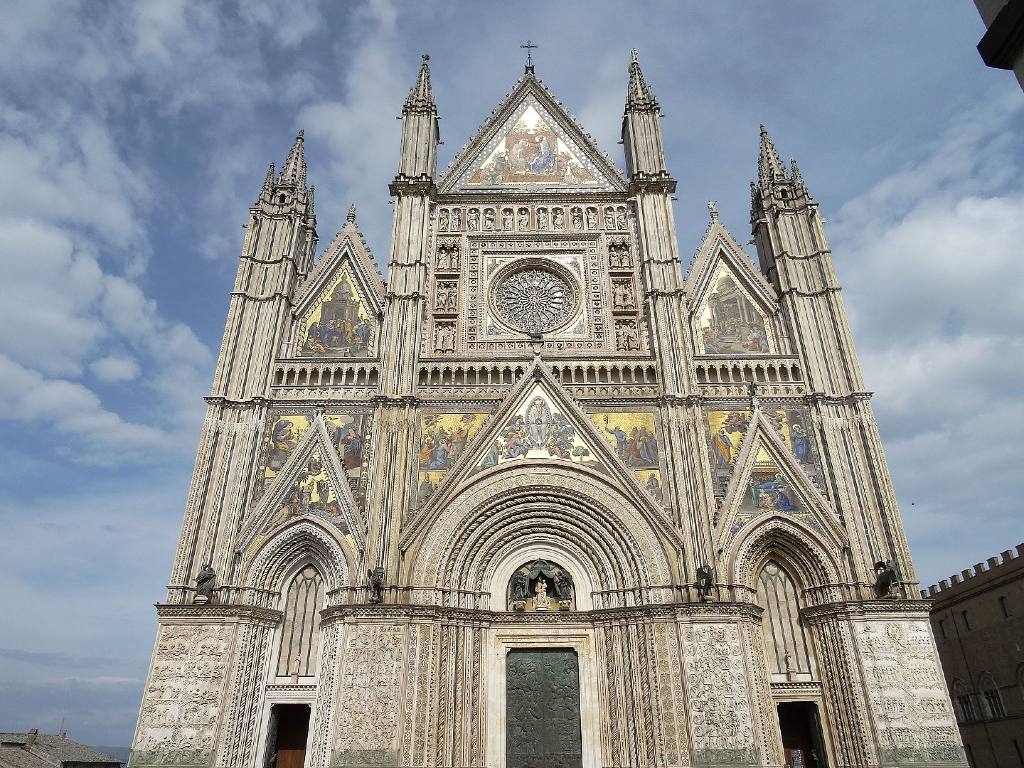
St. Stephen’s Cathedral – Vienna, Austria
Dating back to the 12th century, the Roman Catholic St. Stephen’s cathedral is located in the first district of Austria’s capital city, Vienna.
The German name is “Stephansdom”, but locals usually call it “Steffl”. This iconic Romanesque and Gothic church is famous for its “Pummerin” bell, colorful roof and south tower (136 m, 446 ft).
The cathedral owns 23 bells, one of which is called the “Pummerin” (“boomer”). It’s the second largest swinging bell in Europe, weighing 20,130 kilograms (44,380 lb).
It only sounds on special occasions, like New Year’s Day.
The roof is covered by 230,000 glazed tiles, which include mosaics of Vienna’s coat of arms as well as the one of the Republic of Austria.
On the south side, above the choir, you can also find the double-headed eagle, which was the symbol of the Habsburgs, who were the rulers of the Austro-Hungarian empire.
The south tower is the highest tower of the cathedral, measuring 136 meters.
In the final days of World War II, St. Stephen’s Cathedral was nearly destroyed. The roof structure, bell frame, and organ burned in a fire.
Thanks to the generous donations by Viennese citizens, it was possible to reconstruct Stephansdom and reopen the cathedral in April 1952.
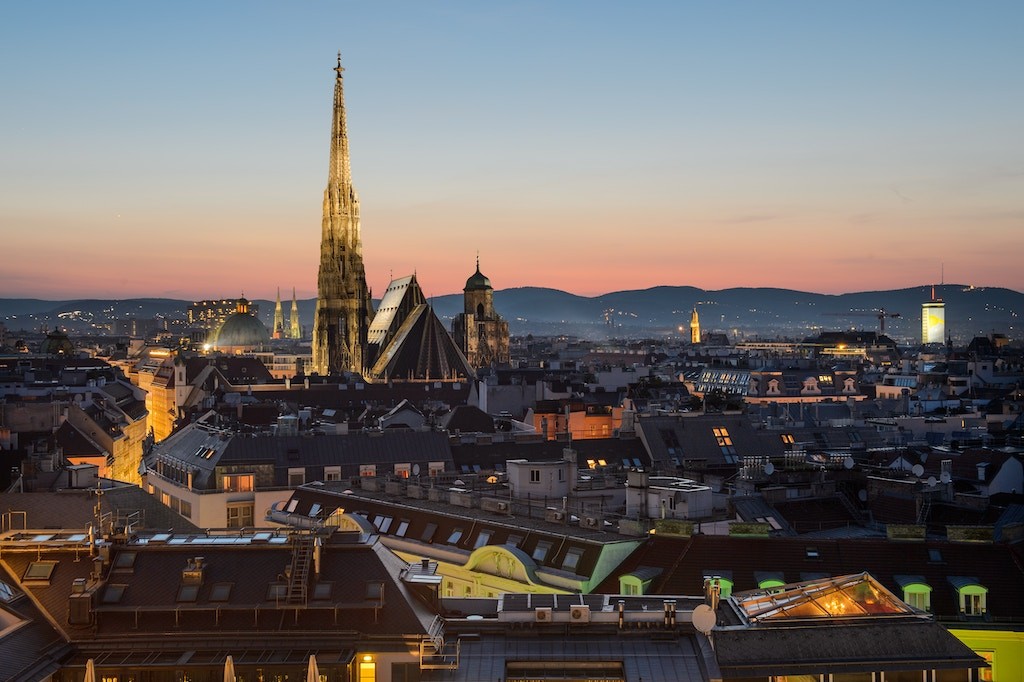
Basilica di San Marco in Venice, Italy
In the heart of Venice, a city full of wonders, is the incredible Basilica di San Marco (St. Mark’s Basilica).
This golden church is a work of art, both inside and out. The domed roof is topped with Byzantine cupolas that frame glittering gold mosaics depicting biblical scenes.
Inside, 500 columns and a further 8,000 square feet of gold mosaics decorate this unique place of worship.
The Basilica di San Marco was founded when Venetian merchants took the remains of the apostle Mark back from Alexandria in Egypt 1200 years ago. There is a mosaic that shows this story above the left door of the basilica.
Once the private chapel of the Doge (duke) of Venice, most of the treasures inside were found during the Venetian Republic’s crusades as far east as Constantinople – today’s Istanbul.
These Eastern influences mean that San Marco has a very different look and feel from the other great cathedrals of Italy.
The wealthy dukes of Venice wanted to ensure their church reflected their power and influence.
No expense was spared in lining the interior and exterior with gold leaf and other treasures.
One of the basilica’s most important features is the golden Byzantine altar screen known as the Pala d’Oro, encrusted with thousands of gems, including pearls, rubies, and emeralds.
The Basilica di San Marco dominates the world-famous piazza of the same name and is an enduring icon of the lagoon city.
Visitors can enter the church free of charge however, there is a small fee to see the Pala d’Oro.
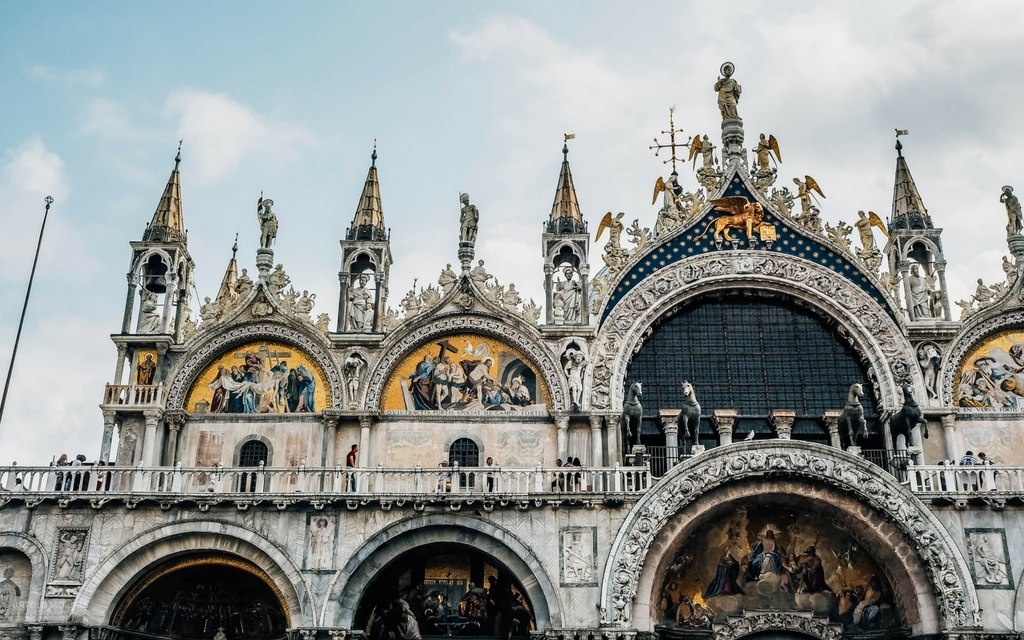
St. Peter’s Basilica – Vatican City, Italy
St. Peter’s Basilica is the mother of all Catholic churches in the world and takes its rightful place in this list of the great cathedrals of Europe.
It is certainly one of the most famous cathedrals in Italy. Perhaps the most famous cathedral in Europe.
While it is located in Rome, Italy, St. Peter’s Basilica is technically part of Vatican City, the smallest city-state in the world.
Every year, millions of visitors flock to St. Peter’s Basilica to attend its major celebrations, masses, or tours.
This massive basilica is one of the largest in the world and certainly the most important.
Some of the highlights are the Pieta (a sculpture by Michelangelo), the Baldacchino bronze canopy, and the cupola climb to the top of the St. Peter’s Dome.
Easter and Christmas masses are held here, and St. Peter’s Square outside the Basilica is where most visitors sit to watch the Pope on large screens.
I highly recommend the unforgettable Scavi Tour. It is a guided tour to explore underneath St. Peter’s Basilica to the humble beginnings of the Vatican Hill necropolis – a cemetery from the time of Christ.
This underground hill marks the very beginning of the Christian faith and is believed to be the site where Peter was crucified and buried.
It is worth a visit to see the remains of Saint Peter (or what’s left of him in a vial). You will see and witness a significant area that is rarely seen by other visitors to Vatican City.
Be sure to reserve your spot way in advance – although Scavi Tour of Vatican City is relatively unknown, it is highly limited and regulated.
You must get approval from Vatican officials to attend.
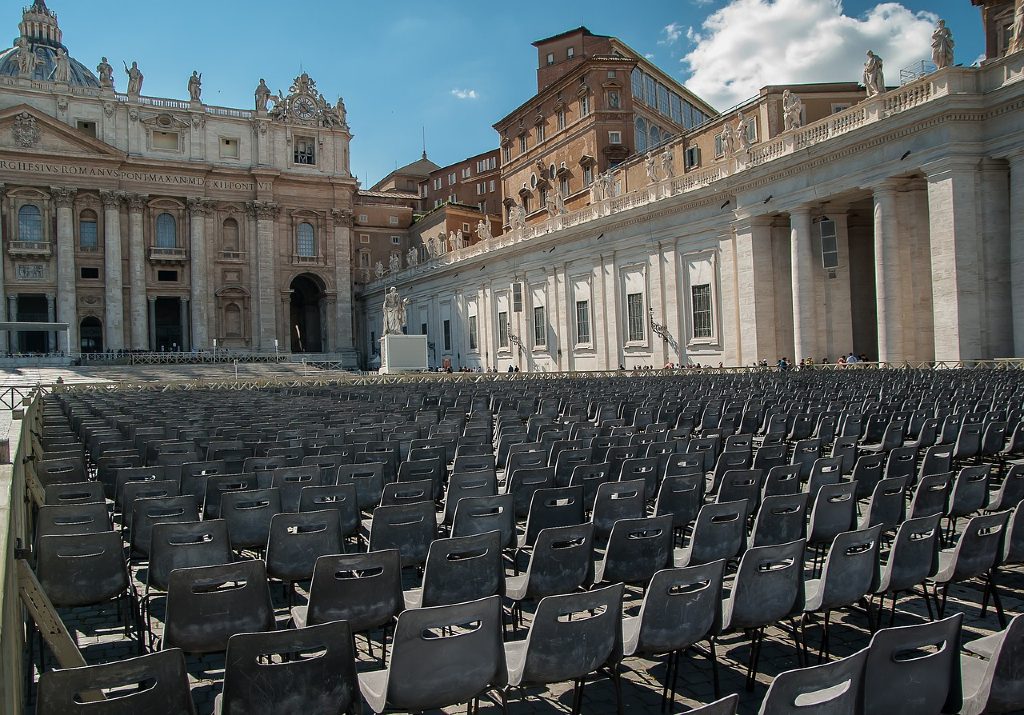
Cathedral of San Giovanni – Turin, Italy
One of the top places to visit in Turin, if it’s your first trip, is the city’s cathedral, devoted to John the Baptist.
Standing tall behind the Royal Palace in Piazza San Giovanni in the historic center, its architectural style shows a mix of Baroque and Renaissance features.
There are many reasons to visit Turin’s Duomo. It was built around the end of the 15th century on the site of three older churches under commission of the Savoy clan, the royal family of unified Italy.
Apart from being the city’s main church, the cathedral is also an important pilgrimage site among Catholics as it has been housing the Holy Shroud, the funerary piece of cloth used to wrap the body of Christ after his death.
In the 17th century, Italian architect Guarino Guarini was appointed to supervise the renovation of the Duomo and build the chapel meant to preserve the Holy Shroud.
In 1997, a huge fire heavily damaged both the cathedral and the chapel where the Shroud was kept.
Since then, the facade and the interior of the dome were restored and the Shroud has now been placed inside a modern shrine made of bulletproof glass, air-isolated and protected from the light.
Visiting the cathedral, you can see the glass shrine where the Shroud is kept at the end of the left nave.
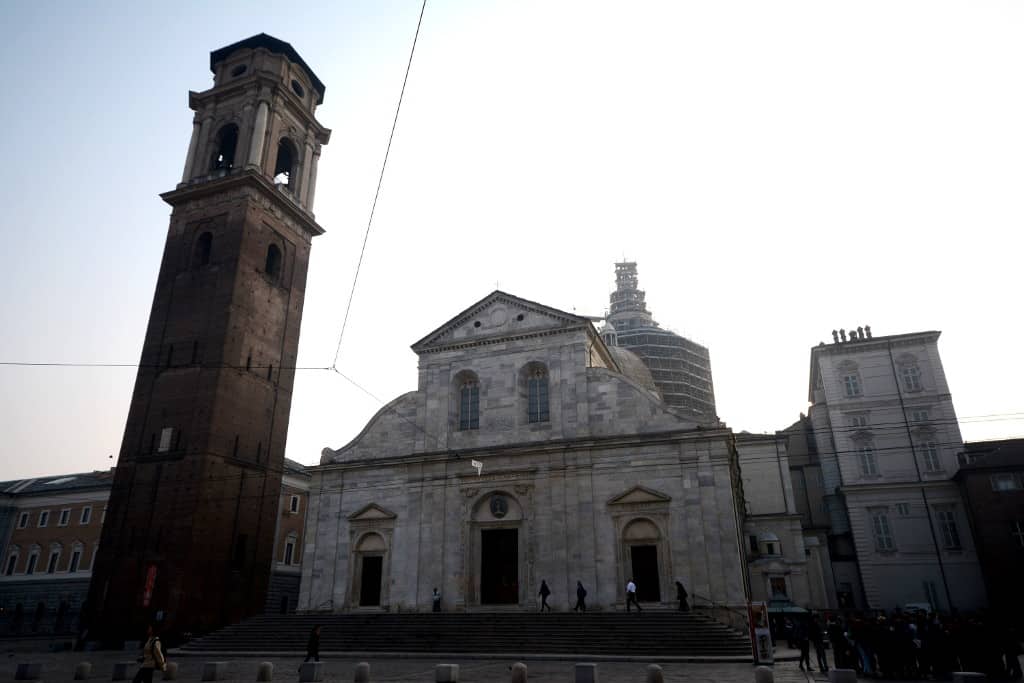
The Cathedral of Lisbon – Portugal
The Cathedral of Lisbon, or the Sé as it’s known in Portuguese, is the oldest church in the city.
It was built by Portugal’s first king, Alfonso Henriques, in 1147.
This was right after the Siege of Lisbon, when Crusaders had defeated the Moors and taken over the city.
Indeed, the cathedral was built right on top of the ruins of the main mosque in Lisbon, which the Crusaders had destroyed.
The 12th century in Portugal was a tempestuous time marred by violence and conflict, and this is reflected in the architecture of the cathedral.
In many ways, it looks more like a fortress than a church, with its two enormous crenelated towers guarding either side of the main entrance.
Fortified churches like this one were fairly common in Portugal during the Reconquest. It was built this way so that it could be used as a base from which to attack the Moors if there was a siege.
The cathedral was badly damaged in the 1755 earthquake and subsequent fire that destroyed most of Lisbon, but it did survive.
Recent excavations in the cloisters have revealed part of the old mosque as well as Visigothic and ancient Roman remains.
The Sé stands at the entrance to Alfama, one of the oldest and most picturesque neighborhoods in the city.
Be sure to take time to explore the surrounding area while you’re here, and stop for lunch at the nearby Princesa do Castelo, one of a growing number of cozy, veg-friendly cafés and restaurants in Lisbon.
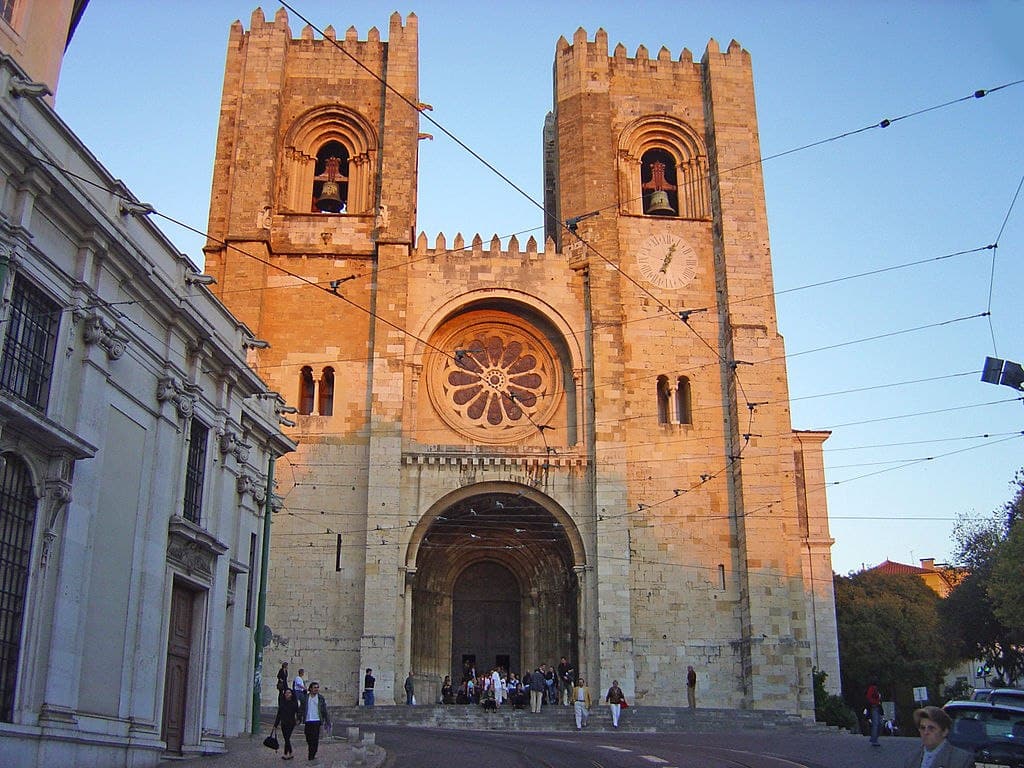
St. Vitus Cathedral – Prague, Czech Republic
Located inside Prague Castle, St. Vitus Church is the largest cathedral in the Czech Republic.
It is officially under the ownership of the Czech government.
There is an entry ticket for visiting the entire cathedral, however, a small section is free for visitors. The ticket for the tour of the cathedral is included in the various sightseeing tours.
To go up the main tower, there is an additional ticket of 100 CZK. However, if you’re visiting the cathedral as a pilgrim or as part of a service, then no ticket is required.
St. Vitus Cathedral is a fine example of Gothic architecture going way back to the 13th century.
With construction starting in the 13th century, the cathedral was actually completed in the 19th century.
The tombs of the cathedral speak volumes of the country’s bohemian roots. There are two towers in the cathedral, with the main tower standing tall at 102 meters high.
The front tower is comparatively shorter at 82 meters.
The exteriors & interiors of the cathedral are equally carved in intricate work. The windows & doors of the church showcase some of the best baroque work in the world.
The windows are adorned with colored stained glass, which fortunately survived the accidental bombing of Prague in World War II.
The cathedral is an architectural masterpiece, and I’d recommend spending some time here to behold its beauty.
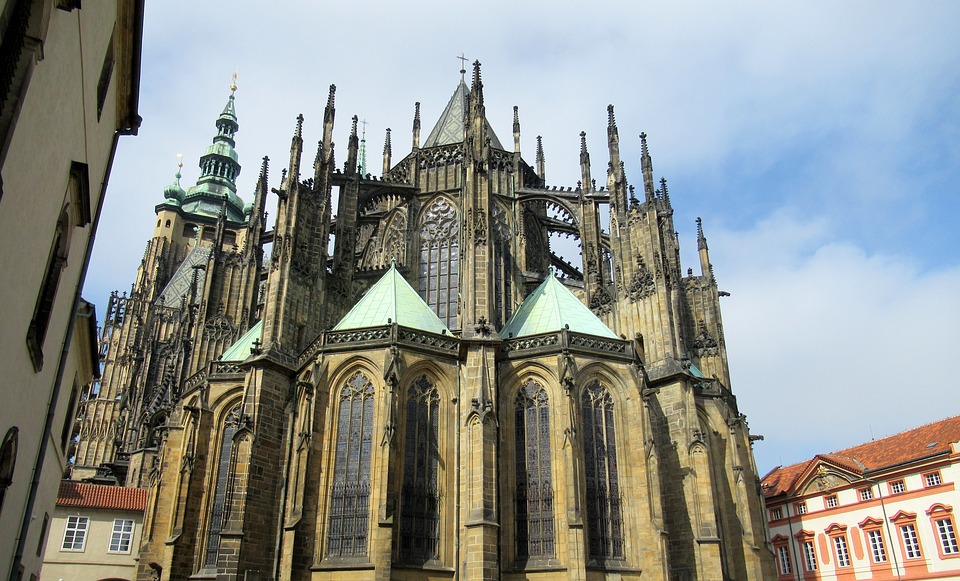
La Cathedral de Santa Creu – Barcelona, Spain
La Catedral de Santa Creu in Santa Eulàlia, or La Catedral for short, is located in Barrio Gótico, in the heart of Barcelona.
Although this cathedral will probably always stand in the shadow of its famous sister, the Sagrada Família, it is definitely worth a visit – for many, it is even considered the prettier.
Visitors are especially excited about the roof of the cathedral, which you can go up to by elevator. From here, you have a wonderful view of the Barrio Gótico, which surrounds the cathedral.
At the site of this impressive cathedral once stood a Roman temple. In the 6th century, it was replaced by a church and inaugurated in the 11th century in Romanesque style.
The construction of the cathedral as we know it today began in the 13th century and lasted until 1448.
In the 16th century, the bell tower was added. However, the extraordinary façade of the cathedral was not built until the 19th century, based on the original plans. Later, a middle tower was added.
La Catedral attracts hundreds of tourists every day. This is a popular meeting place.
On the square in front of the cathedral, traditional Catalan dances or similar performances take place.
The Christmas markets are worthwhile. You can buy traditional Christmas decorations and craft goods.
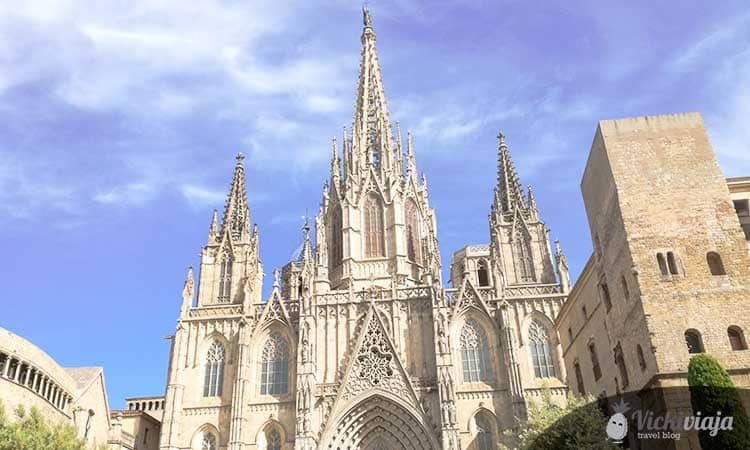
Wawel Cathedral, Poland
The Wawel Royal Cathedral of St Stanislaus B. M. and St Wenceslaus M., as it is officially known (in English), is conveniently located within the Wawel Castle, a top attraction in Poland’s most visited city.
You could spend a good half-day exploring the entire compound and its museums, which are steeped in the country’s rich history.
The cathedral was first built in the 11th century, but most of the current structure dates from the Renaissance.
Multiple Polish kings were crowned here in the days when Krakow was the Polish capital.
Only St Leonard’s Crypt survives from the early period, and it is the final resting place of Polish royalty and luminaries.
One can walk among the tombs of the likes of King Jan III Sobieski, the poet Adam Mickiewicz, Lieutenant General Tadeusz Kosciuszko, and First Marshal Jozef Pilsudski.
The cathedral and the castle are reminders that Poland was once a great and influential country, and that makes them powerful symbols of the nation.
Besides going underground, one can also climb the bell tower to see the rest of Krakow from the top and touch the Royal Sigismund Bell.
The cathedral’s largest bell turned 500 years old in 2020. Make sure to touch it with your left hand for luck.
While admission to the cathedral itself is free, a ticket covering the Sigismund Bell, the cathedral museum and St Leonard’s Crypt costs 12 PLN.
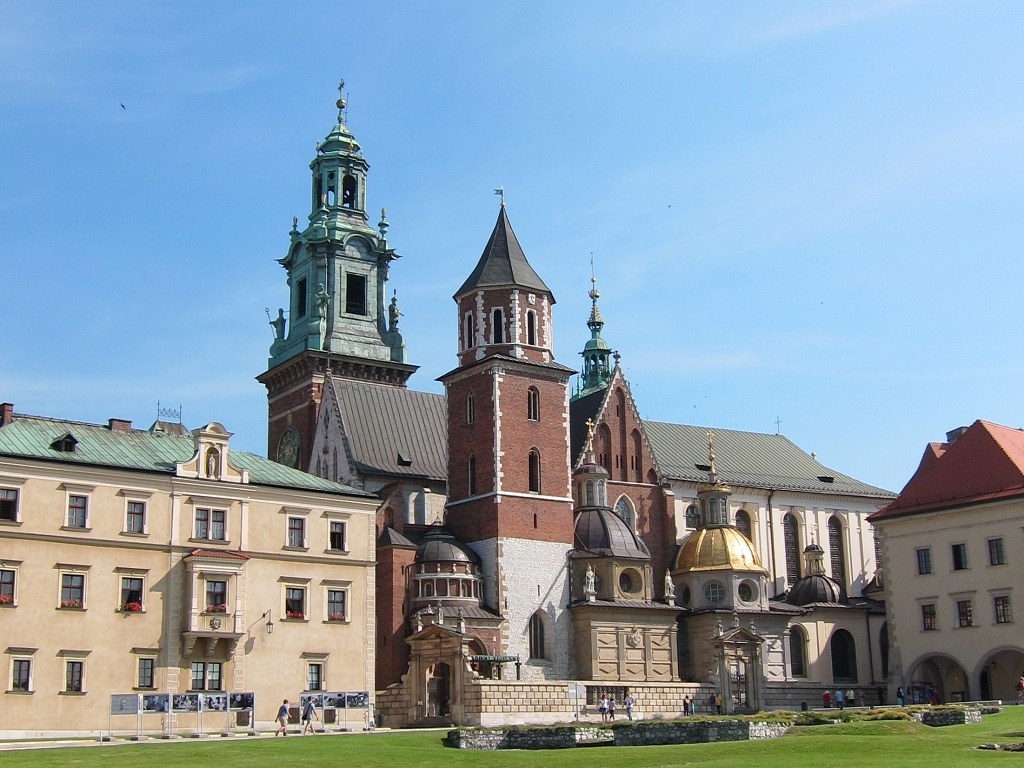
Seville Cathedral – Seville, Spain
The magnificent Seville Cathedral must surely rank among the great cathedrals of Europe, but it has an unusual origin.
When the foundations of today’s cathedral were started, Seville was under Islamic rule, and the original building was a grand mosque.
After the Reconquista, when Seville was captured by the Christian Ferdinand III, the mosque was converted into a Christian church overnight.
You can still see traces of its Islamic origins today. The grand Giralda bell tower was originally the mosque’s minaret.
As Seville became more and more wealthy and powerful, the authorities wanted to build a centerpiece cathedral that would express the city’s might. From the 1400s onwards, the old mosque was remodeled and rebuilt.
The cathedral’s makeover took over 100 years, and you can see clues in the architecture that show just how long it took; as you move from one end of the cathedral to the other, the style becomes less Gothic, more Renaissance.
Today, Seville Cathedral impresses hundreds of thousands of visitors every year with its size.
It’s the largest Gothic cathedral in the world and the third-largest church overall (although both titles are somewhat disputed).
The best way to understand the unique architecture of Seville Cathedral is by taking a guided tour of its secret passageways and rooftops.
On this amazing tour, which is run by the cathedral itself, you can go through hidden doors, climb staircases inside columns, see the masons’ marks of the men who built the cathedral and see the enormous nave from above.
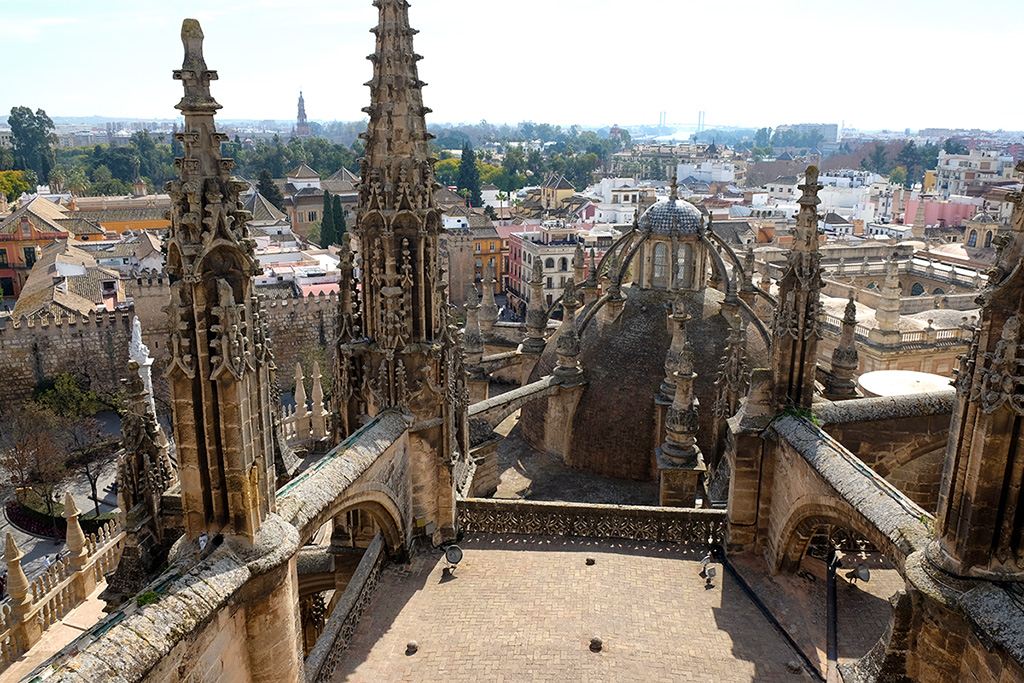
Milan Duomo – Milan, Italy
The Milan Duomo is one of the most magnificent architectural masterpieces of all time and is surely one of the great cathedrals of Europe.
It took six centuries to build the Gothic cathedral near the city center of Milan, Italy. Construction began on the cathedral in 1386, and it wasn’t considered complete until 1965.
With its intricate spires, pinnacles, gargoyles, and thousands of statues, it is easy to see why it took thousands of workers and nearly 600 years to complete the elaborate cathedral.
The Milan Duomo, or Duomo di Milano in Italian, is the largest cathedral in Italy and the fifth-largest Christian church in the world.
The inside of the cathedral is just as breathtaking as the exterior of the church. The church pews are surrounded by large marble pillars and elaborate altars.
The Duomo also houses the largest pipe organ in all of Italy. For an up-close view of the Duomo’s detailed construction, guests can visit the terrace on the roof of the cathedral.
The terrace looks out over the piazza through the forest of spires and offers impressive views of the city.
On a clear day, you can even see the Italian Alps in the distance from the Duomo’s rooftop terrace.
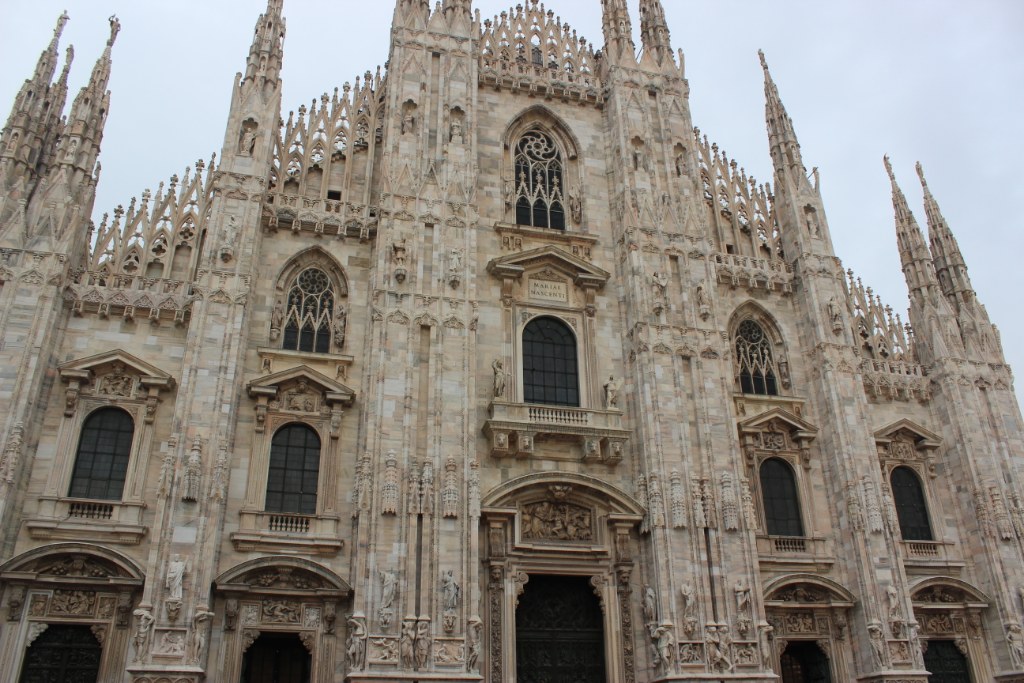
Rouen Cathedral – France
Rouen Cathedral is probably one of my favorites in the world.
It’s stunning gothic architecture and charm both inside and out is what truly brings it to life. The cathedral is otherwise known as “Cathédrale Notre-Dame De Rouen”.
This beautiful cathedral dates back to the 12th century and stands on what was once a 4th-century church, so it’s old!
The cathedral is most famous for its gothic grandeur, stained glass windows, and stunning sculptures. A visit will also take you to the vaults of famous kings, which is super interesting.
This includes the tomb containing the heart of Richard the Lionheart, who was King of England.
Another great thing about this cathedral is that it’s totally free to enter and you can spend as long as you want wandering around and exploring the beauty on offer.
The cathedral is the centerpiece of the old town of Rouen and you can either start or end your explorations here.
Either way, it’s easy to find, beautiful to see and a truly wonderful cathedral in Europe.
If you want to avoid the crowds, then I suggest heading either early in the morning, or late evening so you can have the cathedral to yourself (I suggest checking mass times too!).
The cathedral itself is open from 9 am to 7 pm, so there is lots of time to explore.
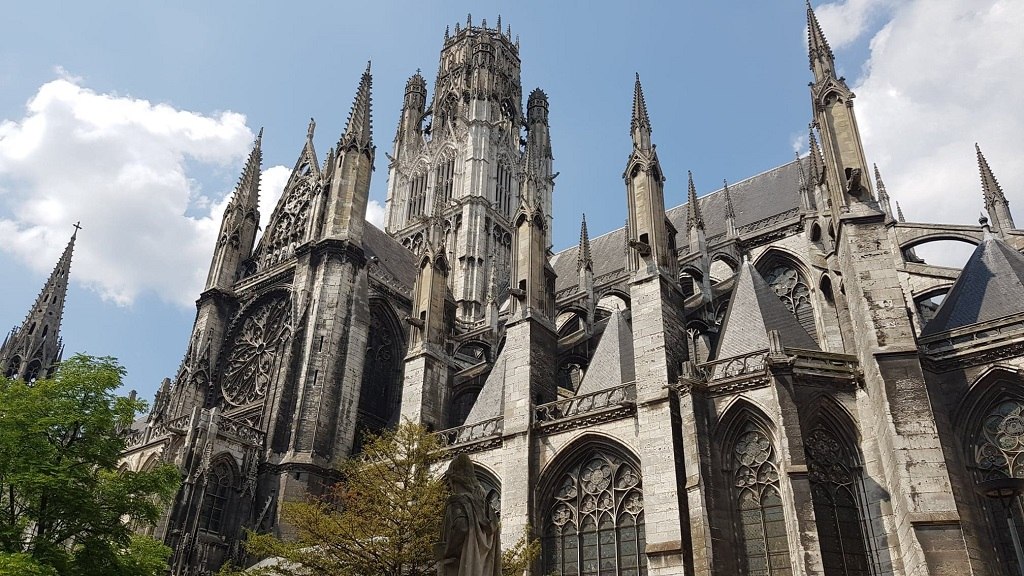
Orleans Cathedral – France
One of Europe’s most haunting cathedrals is Cathedrale Sainte-Croix de Orleans, famous for being visited by Joan of Arc when she was in Orleans to try to lift the British siege of the city during the Hundred Years War.
It’s located in the heart of the Loire Valley, just over an hour by train from Paris.
What may surprise many visitors is that the building that stands there today isn’t the same one that she visited! Historians believe that the first church on the site was built as early as 330, but that there have been four different churches there over time.
The original church succumbed to the same fire that destroyed much of the town.
The second cathedral, built in the 12th century, wasn’t well-engineered and collapsed on itself within a century.
The third cathedral, which was visited by Joan of Arc, was destroyed by 16th-century Protestants during the Wars of Religion.
The final cathedral, which still stands proudly in the center of town today, took the entire 17th century to build; the finishing touches (the main facade and bell towers) weren’t completed until after the French Revolution.
The cathedral’s Gothic style is common of the era, but the story told inside is a unique one.
In honor of Joan of Arc’s bravery in fighting the English invaders, the walls of the cathedral are adorned with ten enormous stained glass panels telling the story of her life, her fight against the English and her eventual capture and execution.
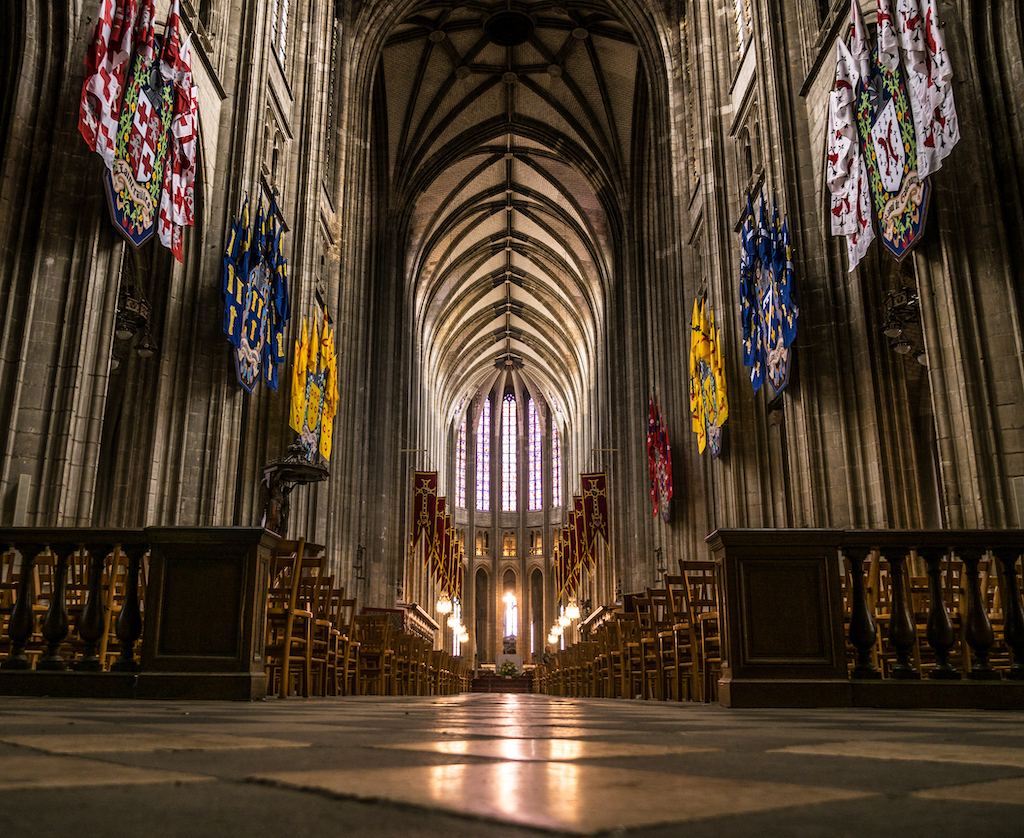
The great European cathedrals of England and Ireland merit their own section.
The Great Cathedrals of England and Ireland
Christ Church Cathedral – Dublin
Christ Church Cathedral, formerly known as the Cathedral of the Holy Trinity, is located in Wood Quay in Dublin City Centre, Ireland.
It is the elder of Dublin’s two medieval cathedrals, the other being St Patrick’s Cathedral.
Christ Church Cathedral is officially claimed as the seat (cathedra) of both the Church of Ireland and Roman Catholic archbishops of Dublin.
However, since Reformation times, it is the seat only of the Church of Ireland’s Archbishop of Dublin.
Founded around 1030 after the Hiberno-Norse King of Dublin made a pilgrimage to Rome, the church was built on a hill overlooking the Viking settlement of Wood Quay.
The church became a priory in the late 1100s and went on to become the wealthiest religious house in Ireland.
During King Henry VIII’s reformation, he converted the priory into a cathedral with a dean and chapter and since then, it has been the formal seat of the Protestant Church of Ireland.
It is a formidable structure and contains the largest crypt in a cathedral in Britain and Ireland, measuring 63 meters in length.
The crypt also contains some fascinating monuments and historical features. Among them is the oldest known secular carving in Ireland.
Also on display is a tabernacle and set of candlesticks used for a “Roman rite” during the reign of King James II. This King temporarily restored Christ Church as a Roman Catholic cathedral.
Lastly, and most incongruously, you’ll find a mummified cat and rat. Go figure.
The nave is reported to house the tomb of Strongbow, a medieval Norman-Welsh peer and warlord. The interior of the church is a marvel, even more so than the exterior.
Guided tours are available and take around 45 minutes and include the nave, belfry, and crypt.
In the belfry, you can try your hand at ringing the cathedral bells, although only those over 12 years of age can access the belfry.
Christchurch is a popular tourist attraction and can be enjoyed if visiting Dublin with kids, although it is probably best suited to slightly older kids.
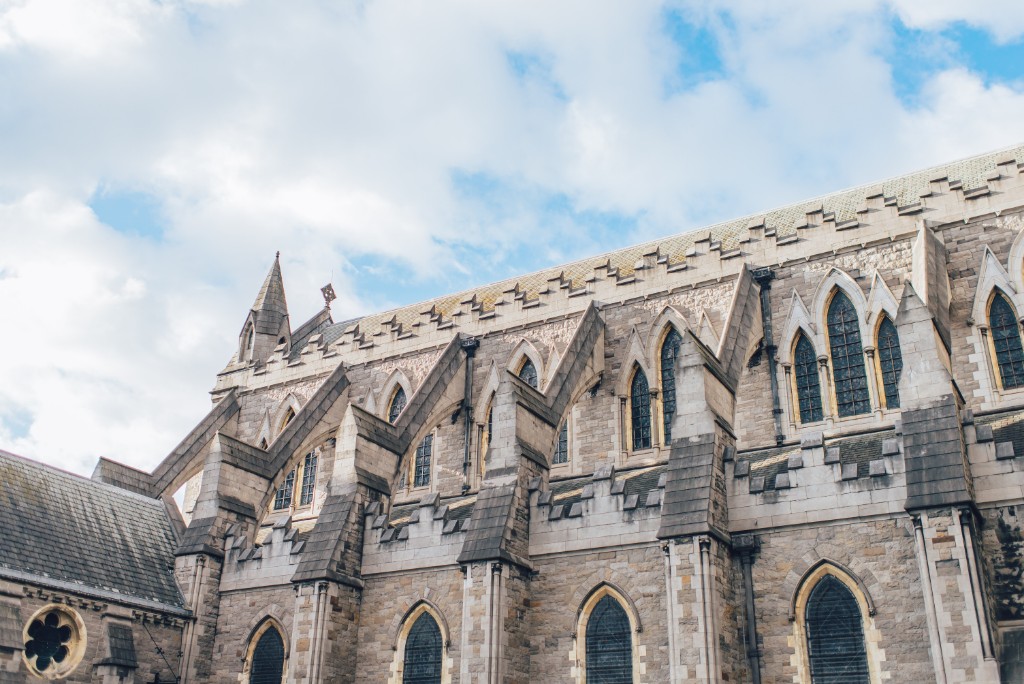
Westminster Cathedral – London
One of the best and most stunning architectural buildings I have seen is the Westminster Cathedral in London. This awesome cathedral is referred to as the mother of all cathedrals in England.
In the 1800s, Catholic worship was heavily frowned upon and was banned in a lot of places.
However, by the 1900s, Catholic worship was allowed nationwide in the UK, and the Westminster Cathedral was created for the Catholic religion.
It sits in the upscale area of Westminster, in central London, part of the West End. The site on which it was built was purchased in 1885, but it was only completed in 1903.
Visitors don’t have to book a visit to see the cathedral, and there isn’t a cost to enter. It’s a free place to see in London and it’s open to the public at all times.
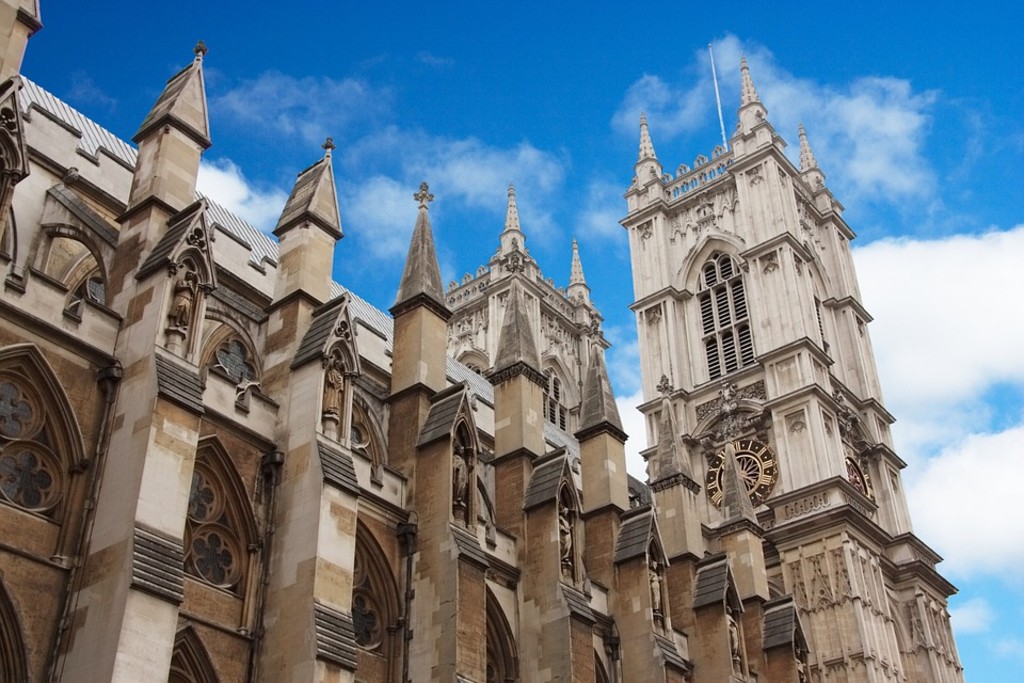
“History and beauty lie in the baroque wrinkles of old cathedrals. mosques, synagogues, temples and faces whose stories are told without a single word.” ― Khang Kijarro Nguyen Share on X
Lincoln Cathedral
Lincoln Cathedral stands proudly at the highest point in the City of Lincoln in Lincolnshire, UK.
You can’t miss the beautiful sight of the cathedral, no matter which direction you approach Lincoln from. It is truly one of the great cathedrals of England.
The construction of Lincoln Cathedral started back in 1072, and building work continued in several phases throughout the medieval period.
The cathedral is Gothic in style and is famous for its gargoyles and statues, especially the local Lincoln Imp. It is the fourth largest cathedral in the UK and is stunning in design.
The highlight is, when visiting on a sunny day, the range of colors cast onto the floor from the stained glass windows. It is a sight to behold.
There is a wonderful cafe located just past the cloisters where there is a lovely grassed spot for kids to run around.
If you are visiting with children, be sure to ask for an explorer backpack. They are included in your visit and there are packs to suit different age ranges.
Lincoln Cathedral is open 7 days a week, however, there are some restrictions with access to the church if there is a service or an event on.
You do have to pay to visit; however, it is reasonably priced, and your entrance fee does include a tour of the cathedral. You can purchase a combined ticket for Lincoln Castle which is a good saving.

Gloucester Cathedral
Gloucester Cathedral is perhaps one of the best-kept secrets of cathedrals worldwide.
Starting life as a monastery, Gloucester Cathedral has stood the test of time, surviving religious turmoil and war to today showcase some of the best examples of Norman and Gothic architecture.
Its stained glass windows are amongst the most important of its kind in England, showcasing Medieval, Heraldic and Victorian glass from the 14th century to the present day.
The famed cloisters are believed to be one of the earliest examples of fan vaulting in England and feature snippets of what life would have been like for monks living here, with spaces for desks and washing places.
Potterheads will recognize the cathedral as Hogwarts since the cathedral was used as a filming location for the first, second, and sixth Harry Potter films.
Perhaps lesser known, Gloucester Cathedral was also used as a filming location for Mary Queen of Scots, Sherlock and Wolf Hall.
There are a number of tours available for a full discovery of almost 1000 years of history. the most notable are the tower tours and the crypts that unveil the resting place of notable people buried at the site, such as William the Conqueror’s son.
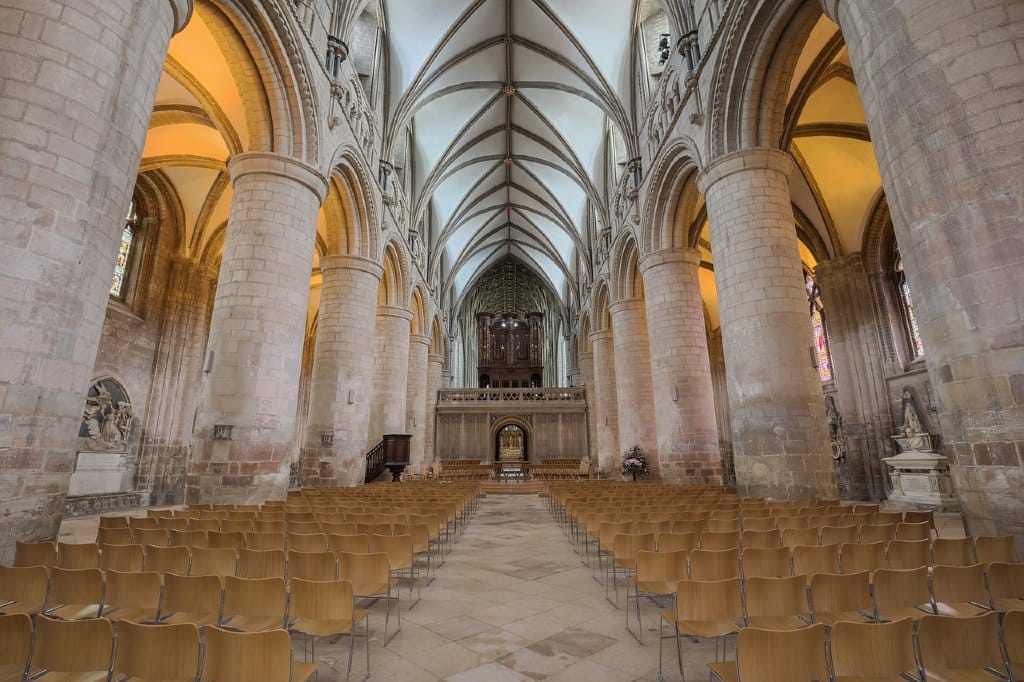
St. Patrick’s Cathedral – Dublin
Ireland’s largest church, St. Patrick’s Cathedral, is easily found in Dublin’s city center, next to a park with the same name.
The cathedral is named after St. Patrick, Ireland’s patron saint. He’s celebrated as the man who introduced Christianity to the Irish people.
It said that he used to baptize people on this site in the 5th century using water from a nearby well.
Therefore, be sure to wander through the park neighboring the church to find a slab making reference to the well’s location.
Today’s cathedral dates back to the 13th century, and visitors can see an image of Saint Patrick reproduced in a stained glass window.
In fact, you can see him on several windows and even depicted in three statues. However, they’re all different from each other, making it a bit difficult to have a real image of this so-celebrated saint.
For obvious reasons, the church is very touristy, which takes away a little of its magic. However, the tiled floor and Gothic architectural style are magnificent.
Also, the arched ceiling gives an impressive look to the central nave.
On the hall surrounding the altar, you’ll find statues, busts, stone tomb slabs, and more. In total, there are over 200 monuments in the cathedral, and each one of them tells a little piece of Ireland’s history.
Address: St Patrick’s Close, Wood Quay, Dublin 8, Ireland
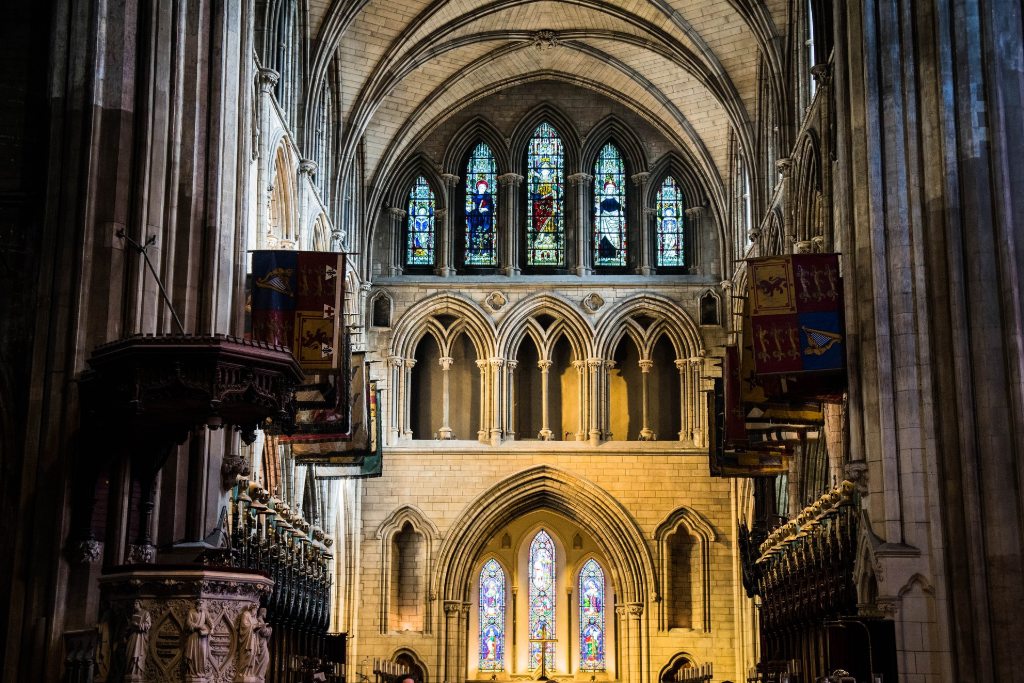
Durham Cathedral
The historic city of Durham is located in the north east of England and is approximately three hours by train from central London.
The compact city is famous for its hilltop UNESCO Heritage Cathedral, which dominates the city skyline. The cathedral is part of the central Palace Green, which is also home to Durham Castle.
Durham Cathedral was built in the 11th century and took forty years to complete.
The intricately decorated cathedral contains the relics of two saints, Saint Cuthbert and Saint Oswald and was a very popular location for medieval pilgrims to visit.
The Chapel of the Nine Altars was constructed in an effort to meet the needs of these pilgrims.
The cathedral is known for its rare, rounded arches, which line the nave leading to the ornate high altar.
The Romanesque arches have unusual, carved Norman pillars supporting them.
The overall look of the cathedral interior is very different from other British cathedrals.
My favorite aspect of Durham Cathedral is the stained glass windows – they are beautiful, particularly the unmissable 18th century rose window.
In addition, there are colorful modern stained glass windows that cast a myriad of colors onto the ancient stone floor. My favorite is the rich tones of the Daily Bread window.
Don’t miss the atmospheric exterior cloisters. Walking around the cloisters feels like stepping back in time.
Harry Potter fans may recognize the cloisters as they were used as part of the school grounds of Hogwarts in the Harry Potter movies.
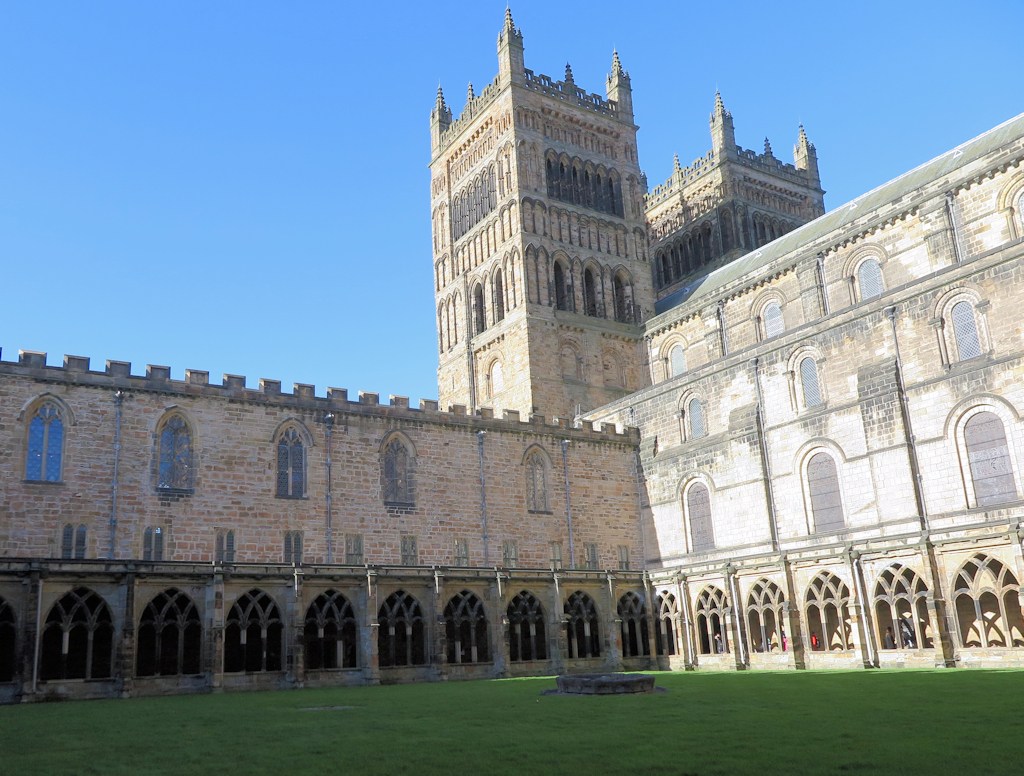
Coventry Cathedral
If you ever wanted to see beauty emerge from devastation, this is an important place to visit.
After Coventry was bombed in 1940 in World War II, its historic cathedral of St. Michael lay open to the sky.
The decision to rebuild was taken the morning after the bombing, with architect Sir Basil Spence creating plans for a new cathedral adjoining the old.
Spectacular stained glass makes the new cathedral glow.
Alongside it, the older cathedral remains a stark reminder of all that has passed, its arches as windows to the elements and small shards of glass delicately positioned in otherwise empty window frames alongside the tower.
Coventry formed a powerful relationship with Dresden; it was significantly affected by bombing in the war. That relationship delivers the message of hope and reconciliation.
The original cathedral space in Coventry contains a number of powerful sculptures articulating this message with elegance and grace. It’s a happy space, too.
On the day I last visited, students were graduating there: a powerful testament to the enduring role of Coventry Cathedral in city life.
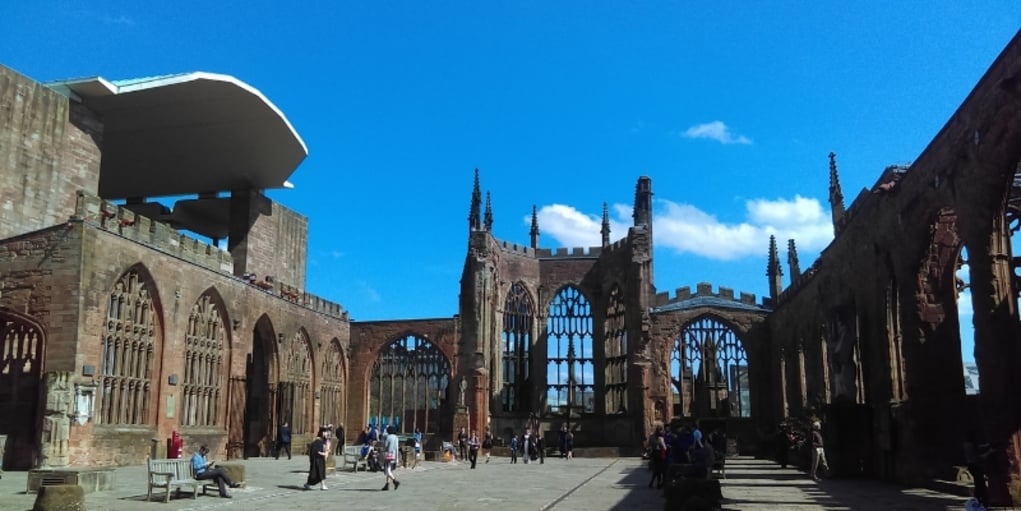
Westminster Abbey – London
Not to be confused with Westminster Cathedral is Westminster Abbey in London, another one of the great cathedrals of England.
Legend has it that in the 6th century, the first Christian king of the Saxons, Saberht, founded a church on a small island in the River Thames.
Later, the church was called the west minster (monastery) and supposedly (miraculously) consecrated by St. Peter.
The more likely story is that about 785 BCE, a small community of Benedictine monks lived on the island and built the monastery.
It was then enlarged and remodeled in 960, only to be torn down by Henry III in 1245 and replaced with the present Gothic-style abbey church.
It has been the site of coronations since the time of William the Conqueror in 1066. It has also held the vast majority of royal marriages since the time of Henry I in 1100.
It is the resting place of many of England’s monarchs and famous British subjects, such as Sir Isaac Newton, Geoffrey Chaucer, Robert Browning, and many others.
In 1987, it was dubbed a UNESCO World Heritage site along with the Houses of Parliament and St. Margaret’s Church, and it is a must-see when planning a trip to London.
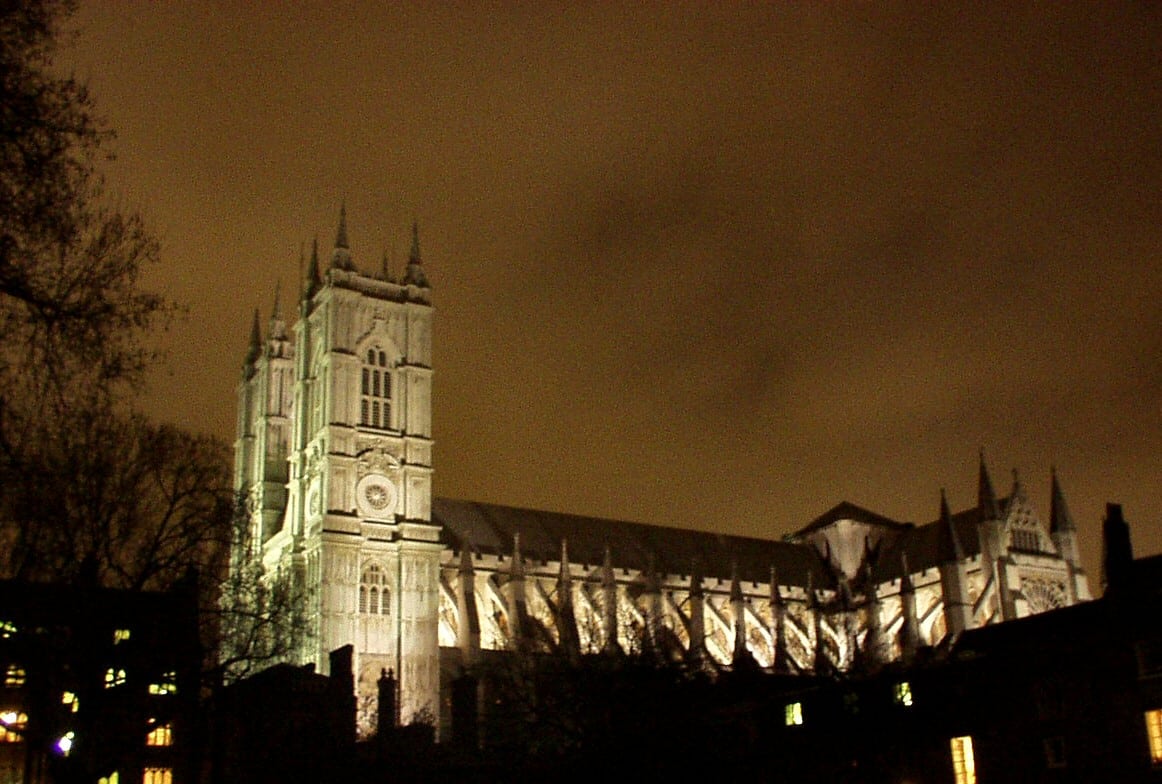
Christ Church Cathedral – Oxford
Christ Church is a hot spot for tourists visiting Oxford and it’s the grandest of all the Oxford University colleges.
What’s unique is that this college also has its very own cathedral, which doubles up as the cathedral of the diocese of Oxford.
This dual role as both a college chapel and Oxford’s cathedral makes it unique in the Church of England.
The cathedral dates back to the 1100s, before the college even came into existence. It only became a college in the 16th century when this site was chosen by Sir Cardinal Wolsey.
The college was actually founded by Henry VIII, who famously separated from the Church of England!
The cathedral also happens to be one of the smallest cathedrals in the country. From the main entrance, you honestly wouldn’t even know it was there.
You enter via Christ Church’s Tom Quad, an enormous and impressive quadrangle, but the cathedral entrance is hidden away in the corner.
Once you’re inside, however, you’ll be wowed by the Norman vaulted ceilings, tiled floors, and beautiful pews.
The famous English philosopher John Locke was a student at Christ Church in the mid-seventeenth century and he is now buried in the cathedral, so look out for that too.
Every evening at 6 pm, the cathedral hosts Evensong. This is one of the best free things to do in Oxford and an opportunity to hear the renowned Christ Church Choir sing.
Interestingly, the cathedral still operates according to Oxford Time, which is 5 minutes slower than GMT, so you’ll have to bear that in mind if you plan to attend!
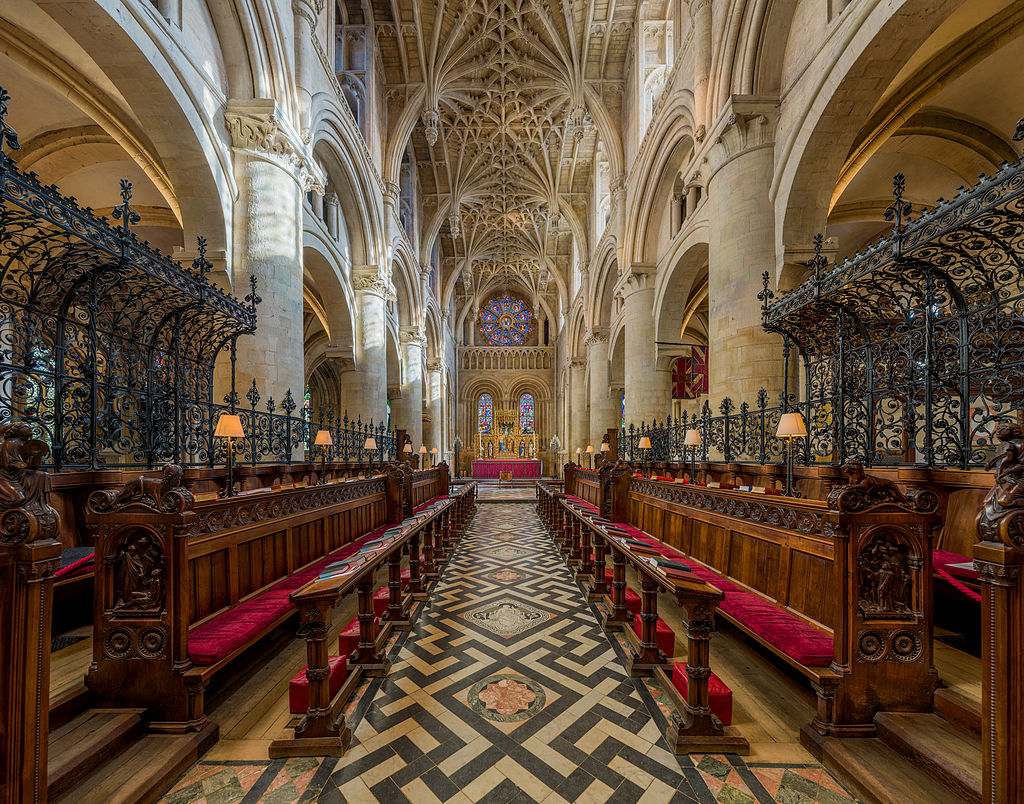
Salisbury Cathedral
Sarum, near Salisbury City, was the site of the first Cathedral in this area. Built on the top of a steep hill, the local people found the place cold and uncomfortable.
When the cathedral was struck by lightning in 1218, they petitioned to build the replacement in a nearby valley.
Work started two years later and Salisbury Cathedral itself was built in just 38 years.
For centuries to come, it was the tallest building in the UK, and even today, it has the tallest spire in the UK and the tallest solid stone spire in Europe!
You can, if you are feeling brave and fit, climb up the inside of the spire almost to the top, where there’s a 360-degree viewing platform.
As the cathedral was built in a valley, it’s remarkable that it has survived so well. Sand and water don’t normally help the foundations of such a massive construction.
It is built in the Early English Gothic style, which helped the builders construct the slim, elegant arches that make Salisbury so distinctive.
The tall and narrow nave has walls made from local light grey Chilmark stone with columns in contrasting ‘Purbeck marble, a limestone from Dorset.
Home to one of the three copies of the Magna Carta and to the oldest working modern clock in the world, it should be on the itinerary of every visitor to England.
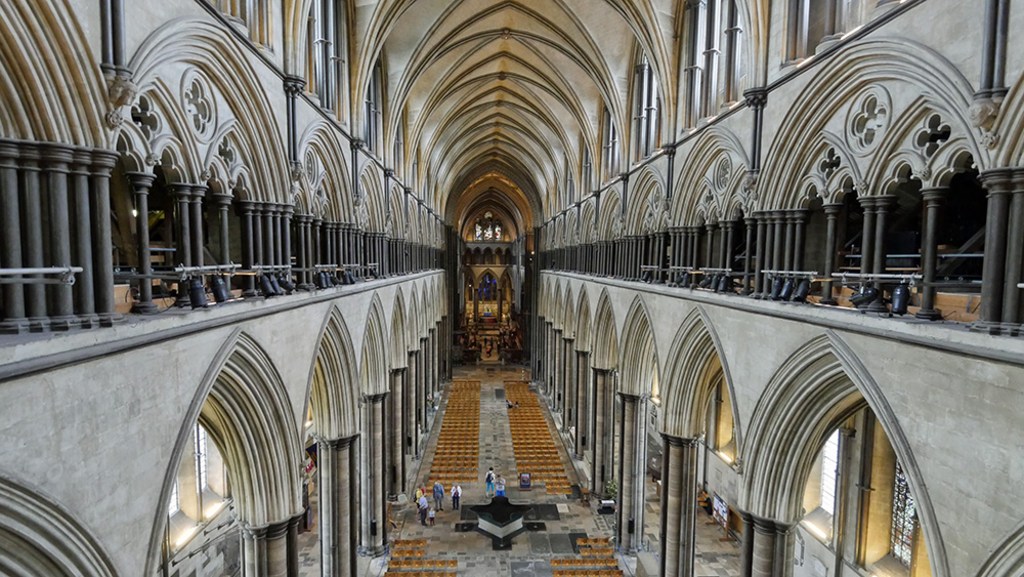
Wells Cathedral
Wells Cathedral sits in the smallest city in England at the foot of the high Mendip Hills.
It is dedicated to St. Andrew the Apostle and is the residence of the Bishop of Bath and Wells.
This cathedral is a short drive from Bristol and Bath and feels more like a visit to a small market town than an English city.
The cathedral was started in about 1175 to the north of an old minster church and has been adapted and modified ever since. The first building took about 80 years to build, and the west front is still there today.
Wells Cathedral is also home to the Wells clock, which is the second oldest clock mechanism in Britain and the oldest of this type of clock face anywhere in the world.
It was made in 1390, and when it strikes, jousting knights move and jack bangs his heels. It is worth finding and waiting for it to chime the hour.
If you look up in Wells Cathedral, you will see amazing arches. These are called scissor arches and were designed to stop the whole building from sinking under the weight of the tower and its lead.
They are beautiful and unique. There are also lots of stunning stained glass windows and tombs within the cathedral, as well as the beautiful Chapter House.
Adjacent to the Cathedral is the Vicars’ Close. It has been occupied for over 650 years and is the most complete example of a medieval close in the UK.
It is joined to the cathedral by an ornate covered bridge and is still in use today.
The Bishop’s Palace is also adjacent to the cathedral and is where the Bishop of Bath and Wells resides. It has a moat and a beautiful garden which can be explored.
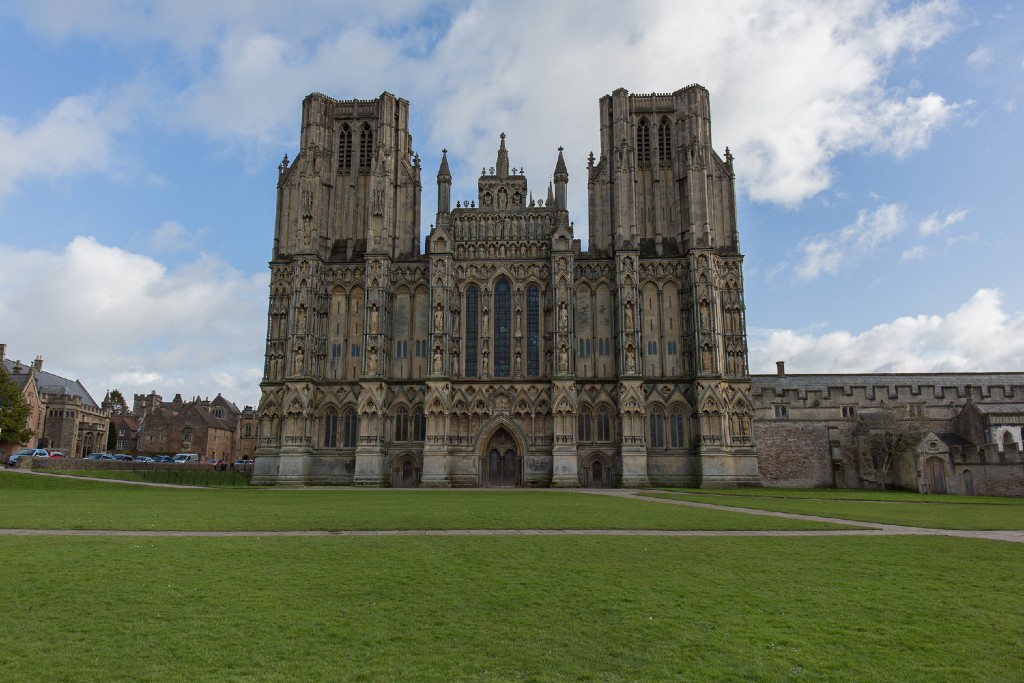
York Minster
York Minster’s history is a long and rich one, and it is definitely one of the great cathedrals of England and northern Europe.
Lying under the foundations are the remains of the Basilica, which was the ceremonial center of the Roman fortress.
It was in 627 when the first Christian church on the site was built, and the first Archbishop of York was recognized by the Pope in 732.
While the Saxon church survived the Viking invasion of 866, it did not survive the invasion of William the Conqueror in 1069.
By the end of the century, a Norman cathedral stood in its place. By 1472, it underwent a Gothic transformation and is the largest Gothic cathedral in Britain.
York Minster is home to some of the best examples of medieval stained glass on earth, some dating back to the 12th century.
The Five Sisters Window in York Minster’s North Transept dates back to the 1200s, and the Nice East Window, which measures as big as a tennis court, was created between 1405 and 1408.
As the natural center of the Church in the North, York Minster often held an important role in some of the biggest moments in Britain’s history, such as the Reformation and the Civil War.
But it has managed to stand the test of time and is surely a must-see when you travel to York.
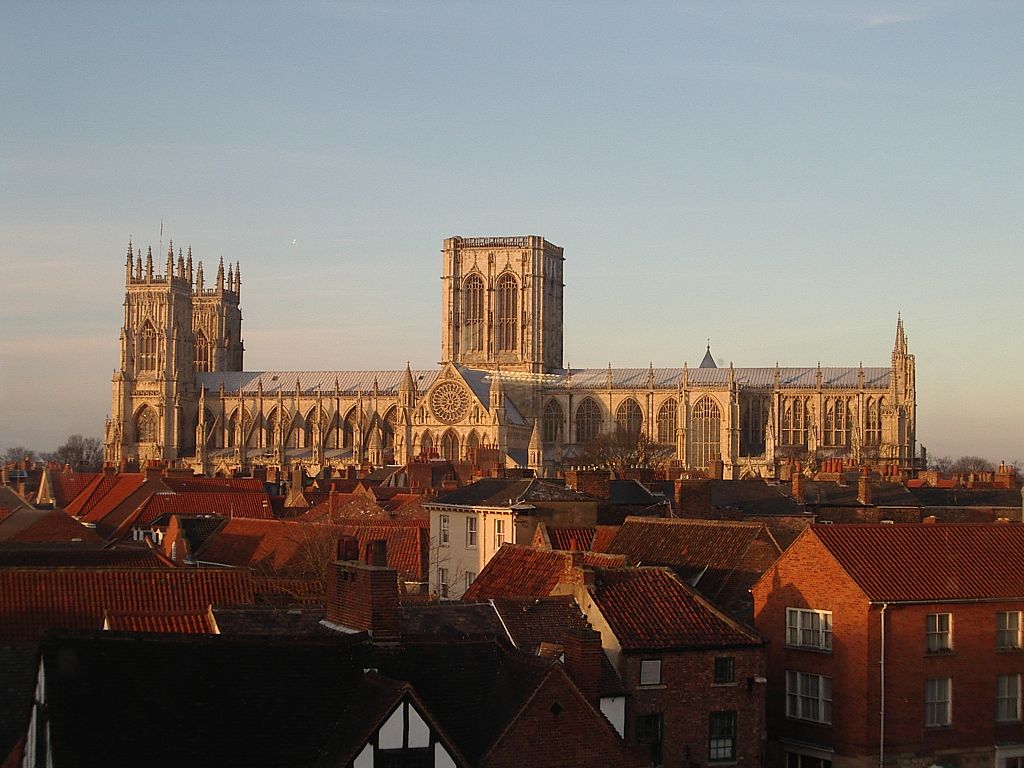
Did we miss any great cathedrals in England and Ireland? Let us know in the comments!
When in London, don’t miss a visit to Southbank, one of London’s cultural centers. Check out the 6 cool things Ireland is famous for.
Learn more about the great European cathedrals with these handy reference books.
Which is your favorite of the great European cathedrals?


BTW, if you are getting ready for your trip, make sure to take advantage of these useful, money-saving links to book your trip:
- Research and book your flight with Skyscanner. I have found them to be the best because they list all airlines including the budget ones. You are always sure of having researched all options.
- For car rental around the world, Discover Cars has flexible pickup and drop-off options, I recommend Discover Cars.
- Book your accommodation with Booking.com. I find they have a wide selection and a nice, user-friendly, transparent website.
- Protect your trip and, more importantly, protect yourself with travel insurance. I use Travelinsurance.com and have been very happy with them.
- Looking for a small group tour to unforgettable destinations with top professionals? Intrepid Travel is your choice.
- For more general tours to any destination or attraction, book with Viator. Check them out.
- Need a visa? Get your visa for all countries with Passport Visa Express.
- Looking for a cool walking tour to explore a city? My favorite walking tours are offered by Take Walks.
- Food and drink tours are the best way to enjoy a city. And Devour Tours are my favorite.
- Looking for a good VPN to protect your security, privacy and freedom online while traveling? Nordvpn is your best option.
- The best and most economical way to stay connected while traveling is with an Airalo eSIM.
I personally use, and can recommend, all the companies listed here and elsewhere on my blog. By booking through these sites, the small commission we earn – at no cost to you – helps us maintain this site so we can continue to offer our readers valuable travel tips and advice.




















4 Responses
I couldn’t think of a more useful post! I’m from the U.K. and love visiting a local church or cathedral when in Europe! I find the architecture simply fascinating. Especially Russian orthodox type churches. There are many I’ve not visited on this post that I have to add to my list now. Basilica of Montserrat looks absolutely breathtaking. I think I’ll make that first on my list.
Yes, I also enjoy visiting cathedrals. The one in Montserrat is especially beautiful. When you go, take the tram up the mountain. The views are spectacular. Thank you for commenting.
Nice list. We have visited plenty of them in Europe (Spain, France, Vienna, Portugal, and Italy). Aren’t their architecture great?
Amazing!